So what is the “most important” guitar in Rickenbacker’s history? Off the top of your head you’d probably say something like George Beauchamp’s first frying pan or a certain 1958 325 hanging on the wall in a music store in Hamburg. Those are solid answers. Certainly, without the first there is no Rickenbacker period full stop. Likewise, without the second, the company would have never grown the way it did.
But I’d argue that the 4001–not a specific 4001, just the 4001 in general—deserves that title. Without the 4001 keeping the lights on at the Rickenbacker factory, the brand likely would not have survived the 1970s. Think I’m exaggerating? In the mid 1960s there were over 100 people building guitars at the Rickenbacker factory. By 1970 that number was down to…8. Without the 4001 Rickenbacker could well be just be another one of those defunct “60s guitar brands” that get the Eastwood treatment today. Yeah. It’s that important.
But before we talk in depth about the 4001 we need to briefly discuss the 4000, Rickenbacker’s first bass guitar.
While the electric bass guitar was only a few years old when the 4000 was first dreamed up, the Fender Precision Bass—which had introduced the concept in 1951–already dominated the market. That said, the market was still quite small—but it was growing and Rickenbacker wanted a piece of it.
And because the market was still new, there were no “standards” yet. For example, the Fender scale length was 34”, Gibson’s was 30.5”, so Rickenbacker came in at…33.25” as they designed their first bass guitar.
The 4000 was designed by Roger Rossmeisl in 1957 and clearly used the same cresting wave design language that would be applied to the redesigned Combo 450 and new Combo 425.
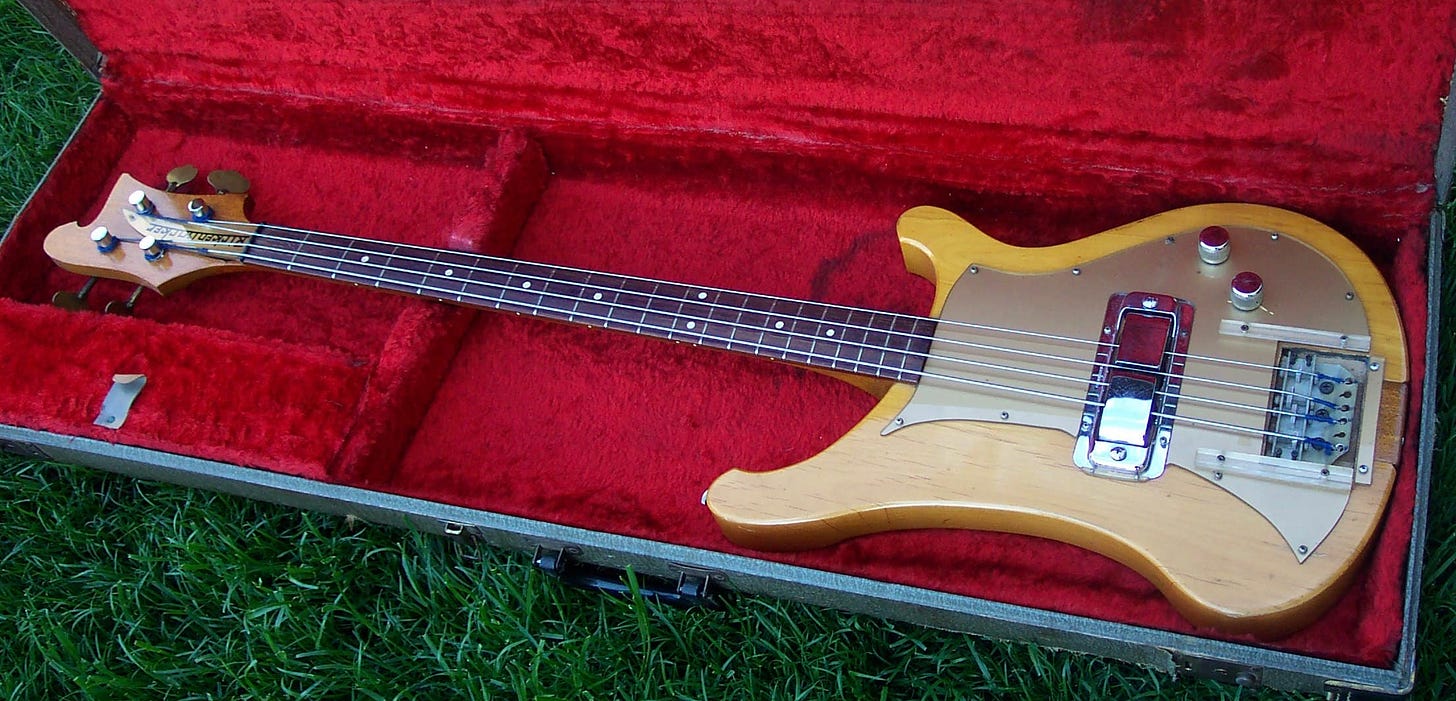
You can see a lot of the finished product in this first draft. The body was thicker, the upper cutaway was shorter, the pickguard was an atomic age design wonder, and the bridge was a modified guitar bridge, but you can see what it would become. So let’s talk about that process!
One caveat before we start. When talking about Rickenbacker—especially in the 1960s and 1970s—expect exceptions. The dates you will find cited here are my best estimation after a LOT of research. But in the real world you WILL see inconsistencies, like an “old” feature showing up after a new one is introduced. These dates are guidelines, not hard and fast rules. Cool? Let’s begin!
1961

Is this the very first 4001? It could be. It’s certainly unique among the handful of 1961 guitars that have been documented. That said, there was at least one 1961 4000 with Deluxe features like this one—the “Vagabonds” bass. Is this THAT guitar modified with a second pickup? We’ll likely never know for sure.
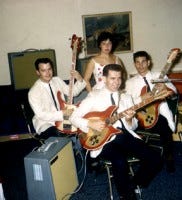
So what makes this guitar different from a 4000 from the same year? Let’s start with the similarities.
The headstock features Kluson 546 tuners and a gold backpainted plexiglass truss rod cover.
The body featured the same gold backpainted plexiglass “atomic-age” pickguard as the 4000, same clear tug bar, same horseshoe pickup in the bridge position, same modified guitar bridgeplate and bridge, and the same two knob control layout with chrome dome topped/reeded edge lap steel knobs.
Now the differences. Notably, body thickness shrank from about 1 5/8” to 1 1/4”, reducing the weight considerably. The bass-side cutaway was extended and its crest became more prominent—maybe to correct for neck dive?
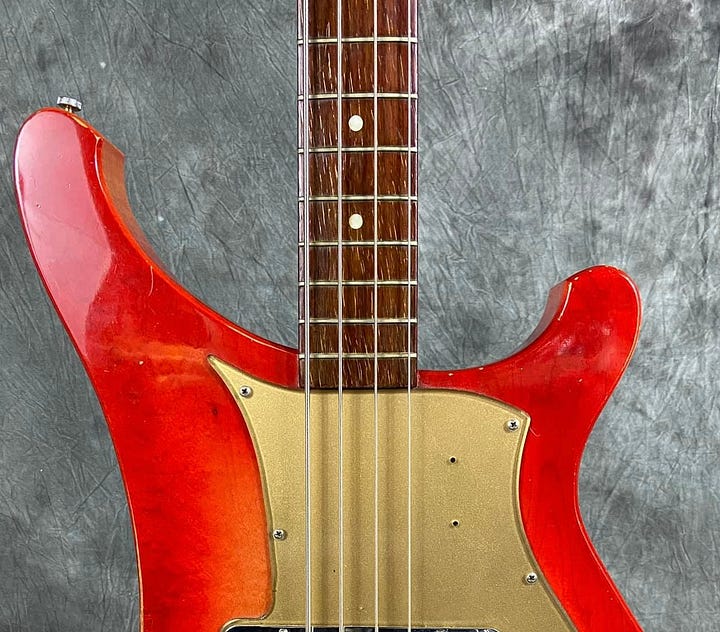
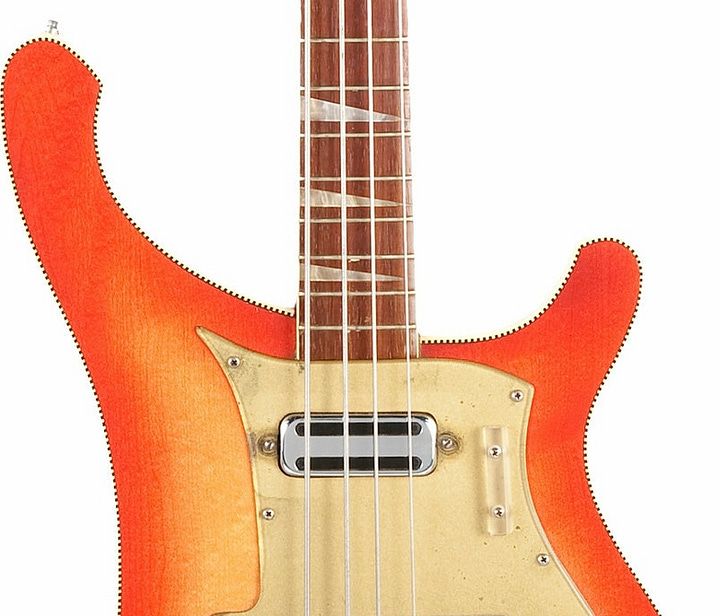
The top gained the checkered binding found on the F-series guitars, and the neck was outfitted with binding and poured resin full-width triangle inlays. And of course there’s a second pickup—a toaster—in the neck position.
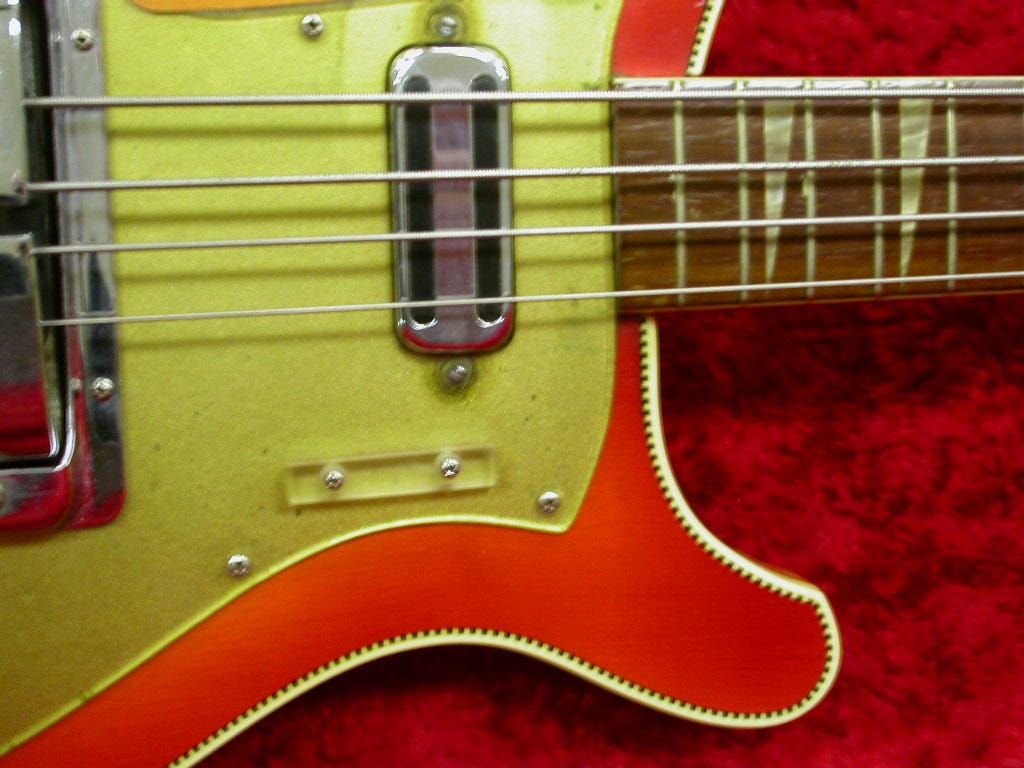
According to Martin Kelly’s book, the first 4001 had a four polepiece toaster pickup at the neck. Sadly we have no pictures under the hood of this one to see if it’s “the one”. But there would be more 4001s made in 1961.
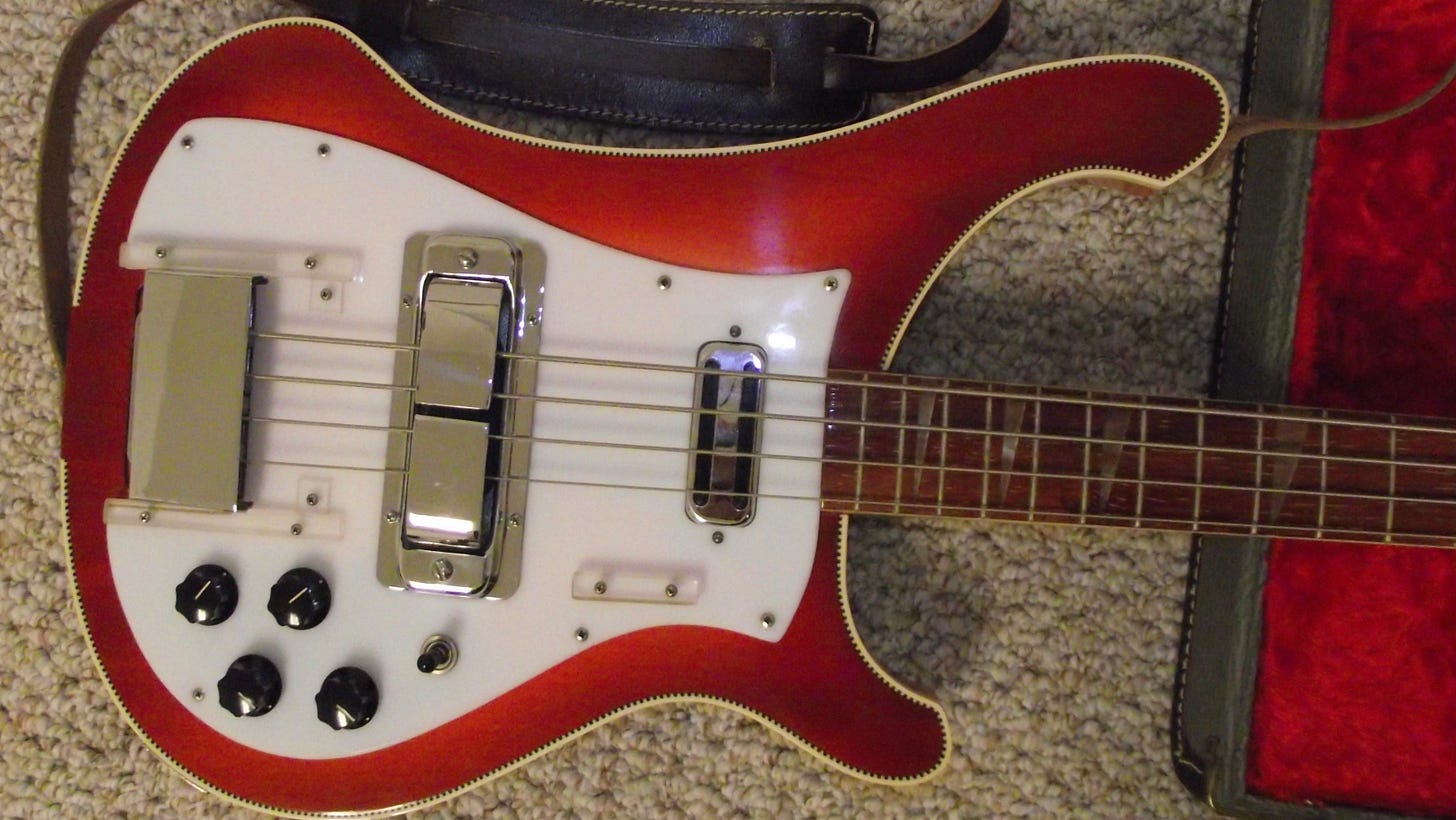
This more well known 1961 4001 iteration got a little bit closer to the one we know today. The pickguard shape was still clearly a work in progress, but was switched to the white acrylic material that was replacing the gold backpainted plexiglass across the entire line. Oddly, the truss rod cover remained gold backpainted. The four knob/1 switch wiring configuration made its first appearance—albeit with a tighter hole pattern closer to period guitars than today’s bass guitars. A handful of these guitars would be made, and then no more 4001s would be produced until 1963. But the basics were in place.
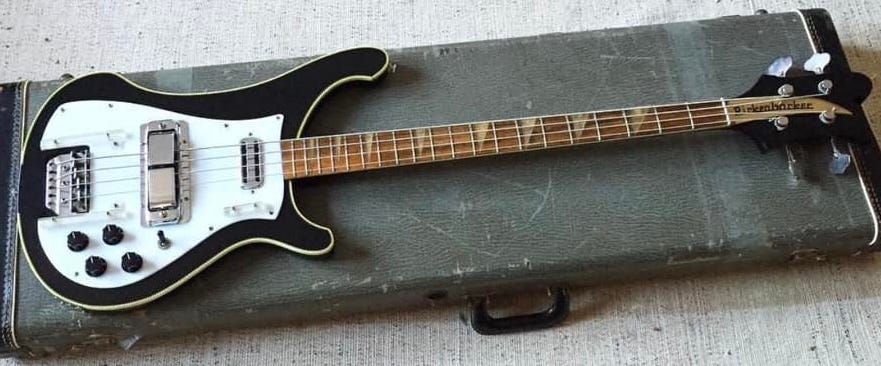
1963
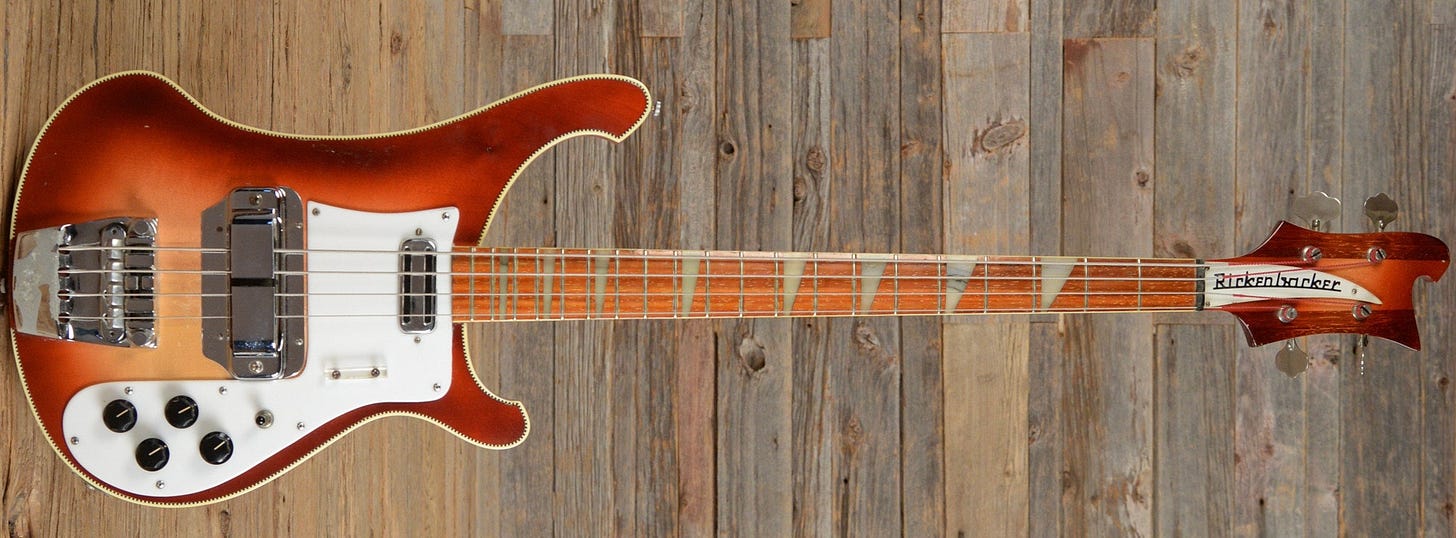
Two years after the prototypes/first few “production” 4001s were built, the 4001 appeared more or less as we know it today. While it’s clearly the descendant of those earlier guitars, almost every detail was different. From top to bottom:
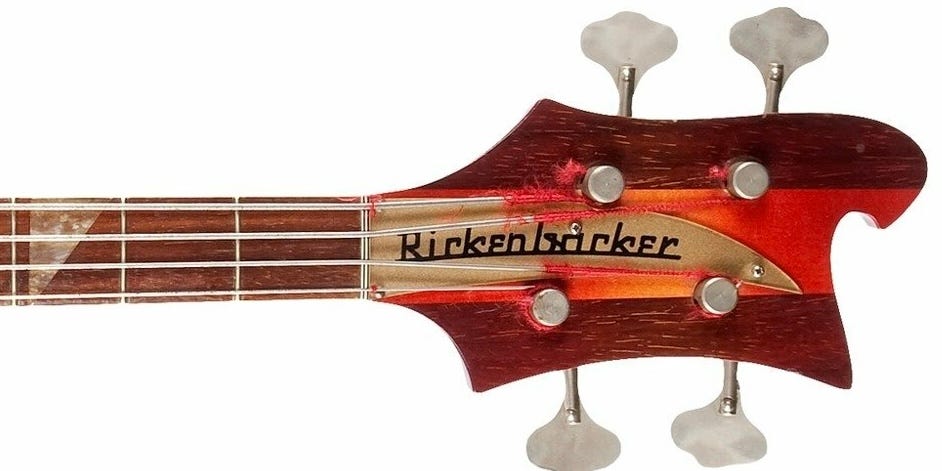
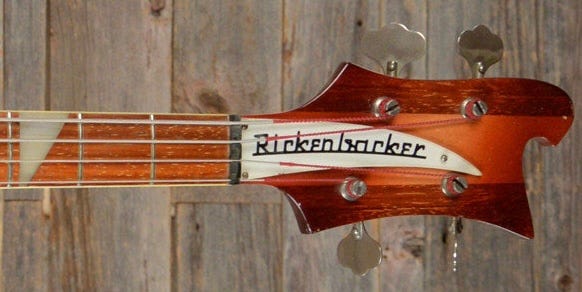
The gold back-painted truss rod cover was replaced by white. The headstock shrunk about 1/2” in width, allowing the frankly monstrous Kluson 546 tuners to be replaced by smaller Kluson 538 tuners.
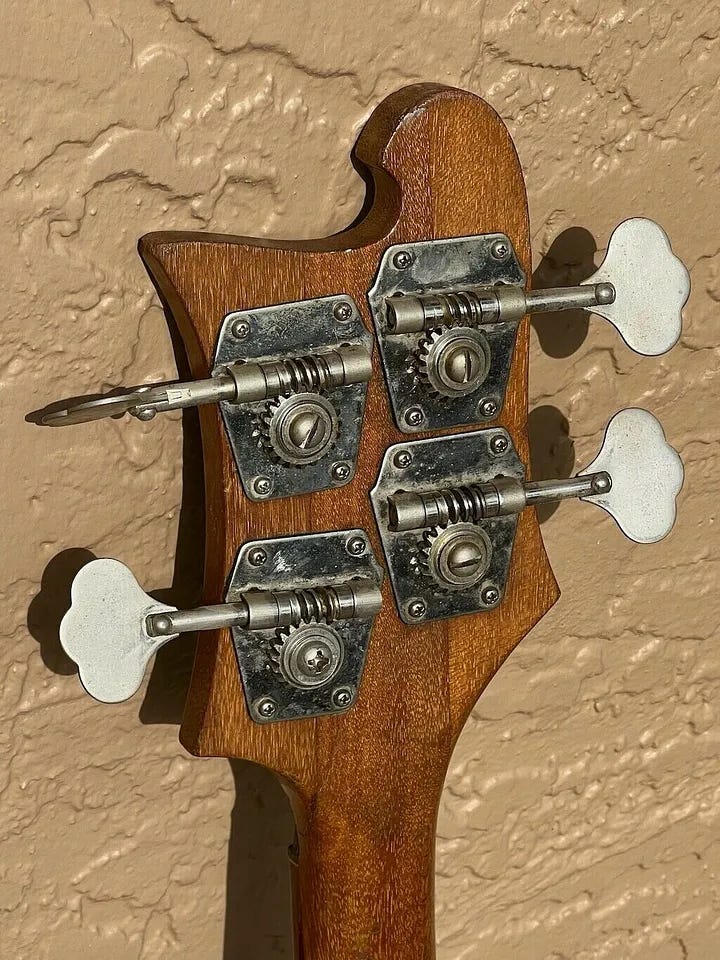
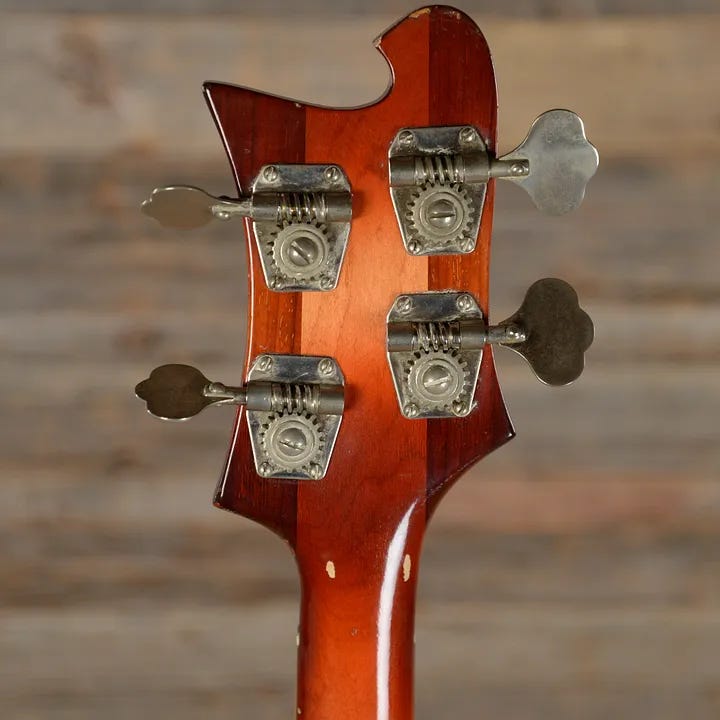
While the outline of the body may have been the same, the face of the guitar was a completely different-looking animal.
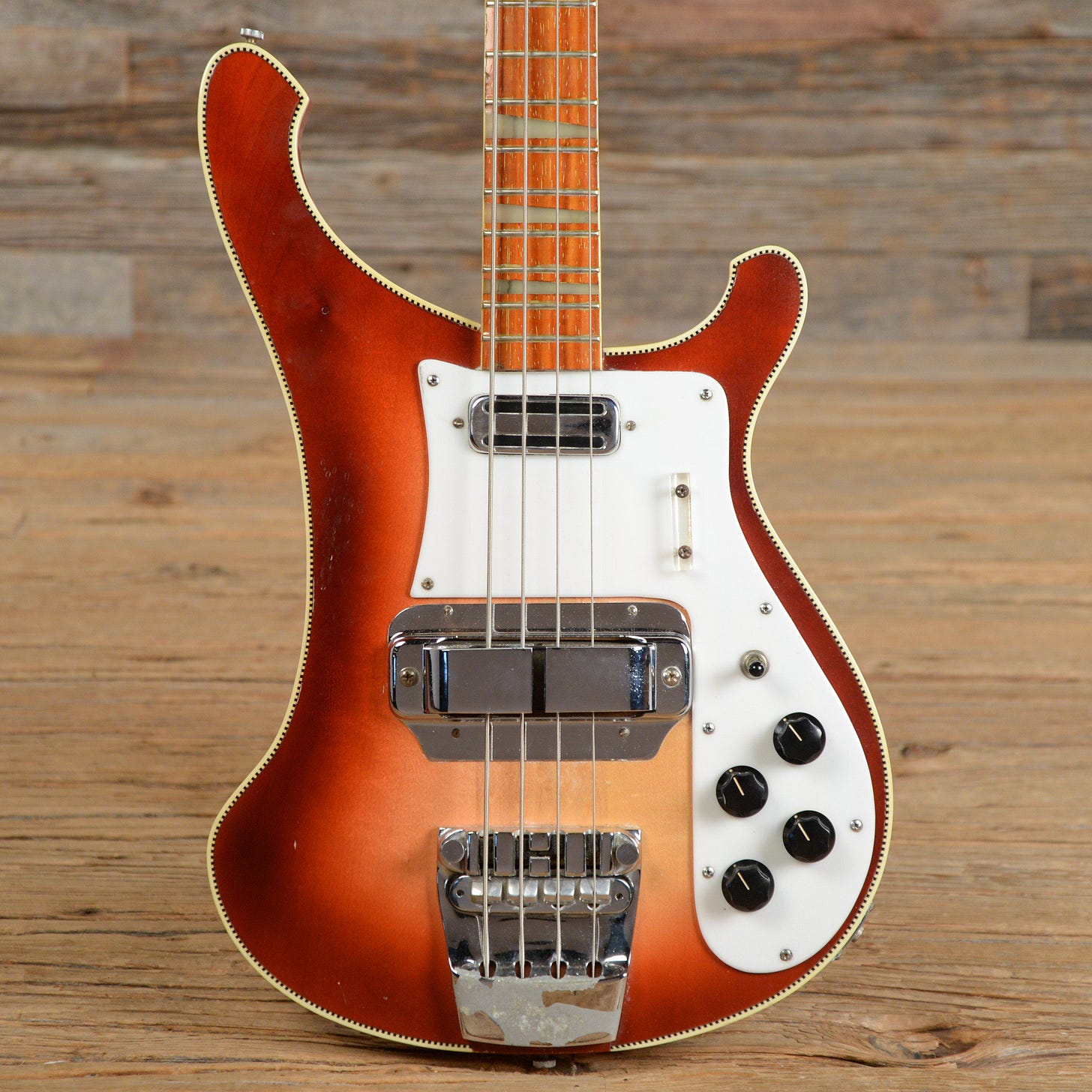
The amorphous blob of a pickguard was replaced with a much more “function-over-form” design. The neck pickup moved about a half an inch closer to the neck. And—finally!—Rickenbacker got a proper bass bridge instead of a repurposed guitar bridge.
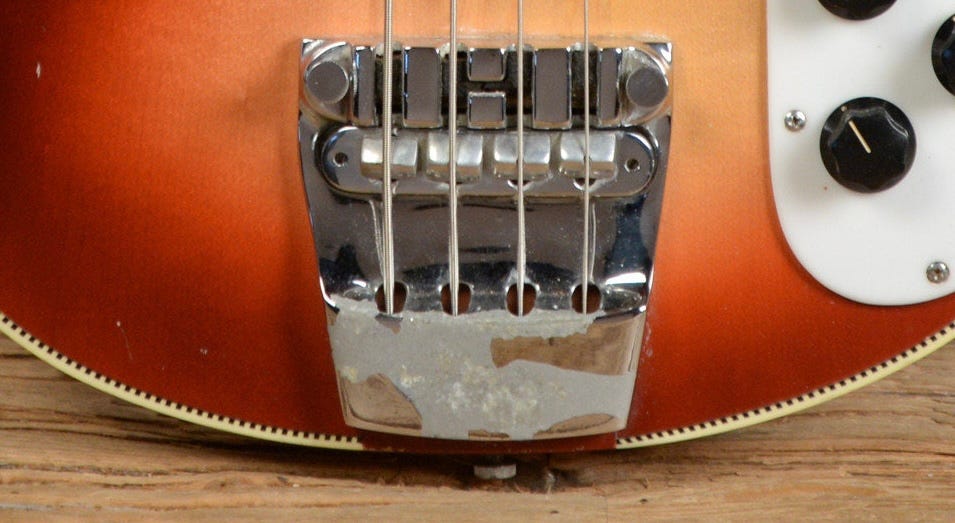
The new chrome-plated cast aluminum base unit attached to body with three screws below a drop-in bridge with four adjustable saddles. The entire bridge could have its height adjusted via set screws located at each end. Two thumbscrews at the very front raised or lowered a foam rubber mute. Fun fact: these were the same screws used for the strap buttons!
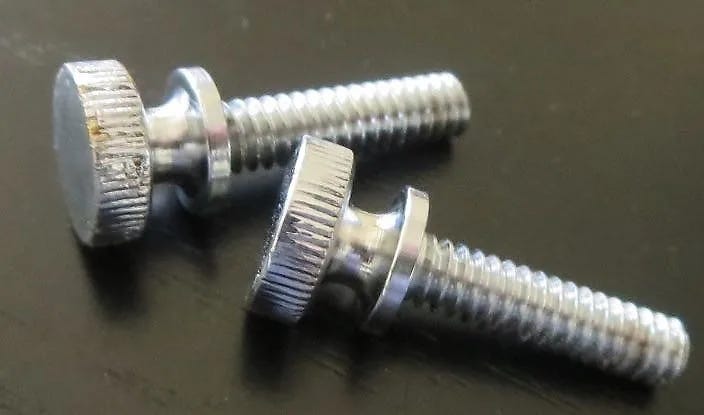
Here’s a nitpicky but interesting detail. While the full-width triangle inlays on the fingerboard utilized the same pearlescent poured resin as used in 1961, the shape was slightly different: the 1961 triangles came to a complete “point” at the edge of the fingerboard, the 1963 (and all subsequent years) triangles had the point “cut off”—probably for ease of manufacture.
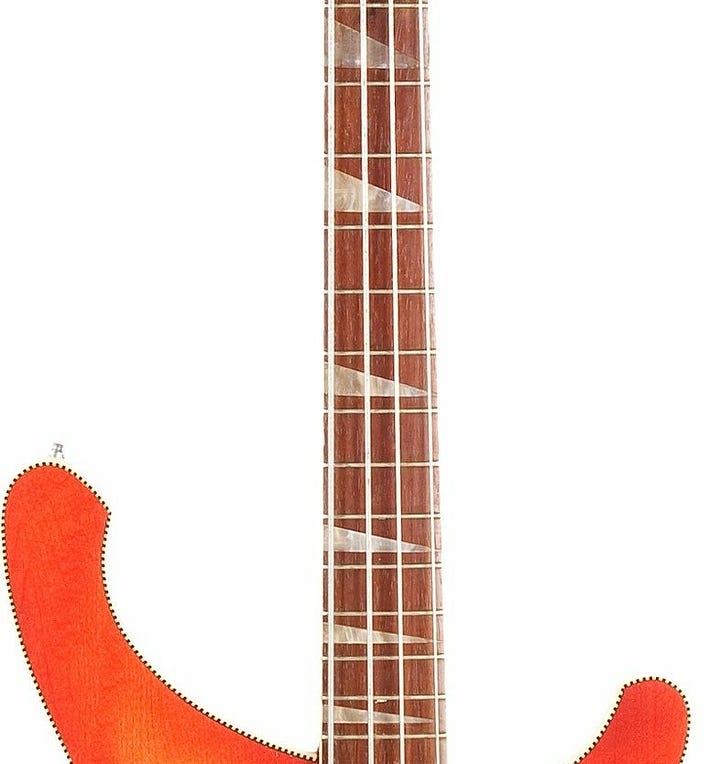
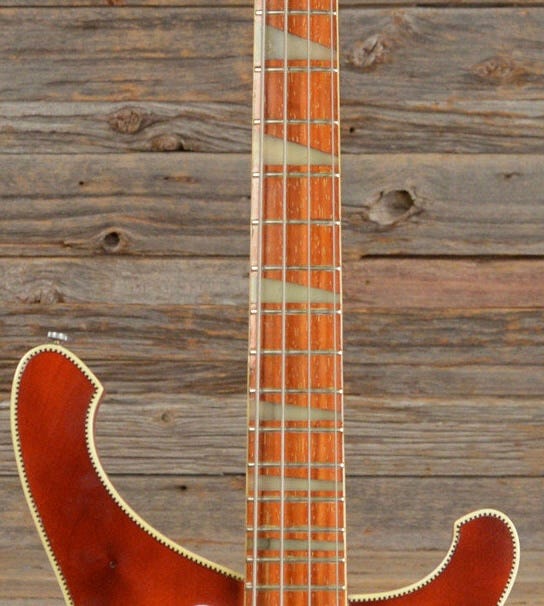
At the same time, the “standard” 4001S was launched. The 4001S lacked the fancy binding and triangle inlays of the “deluxe” 4001, featuring instead a slightly contoured top and dot inlays—although only to the 17th fret.
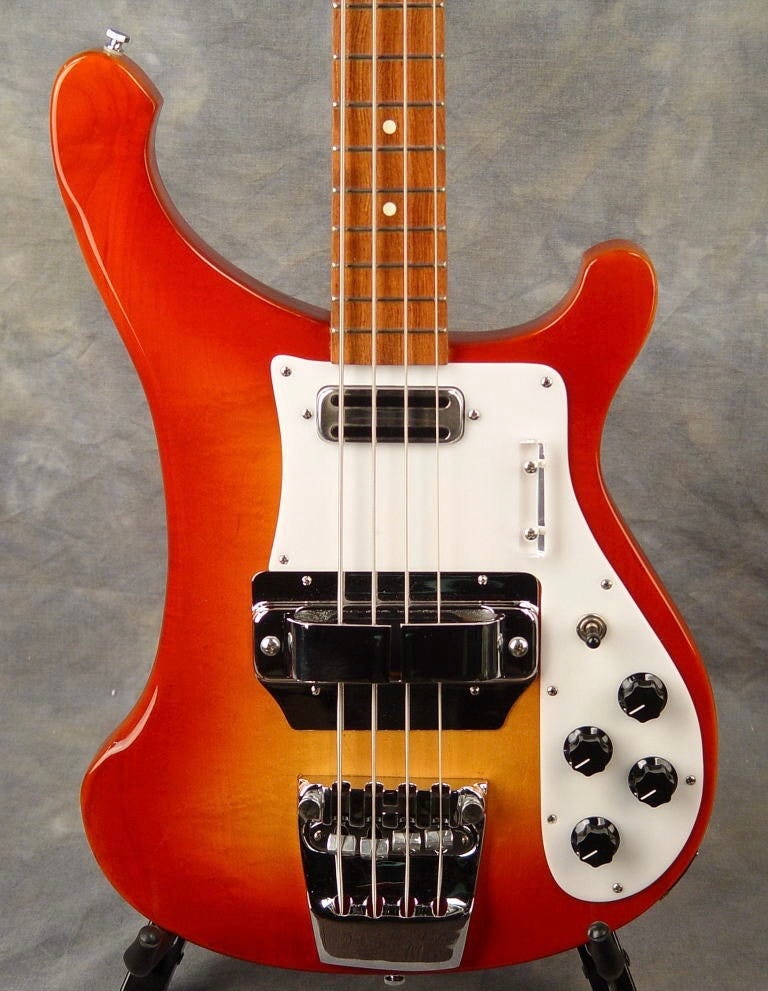
And with that, the template was set—although continuous minor tweaks would become the norm for the next ten years!
1964
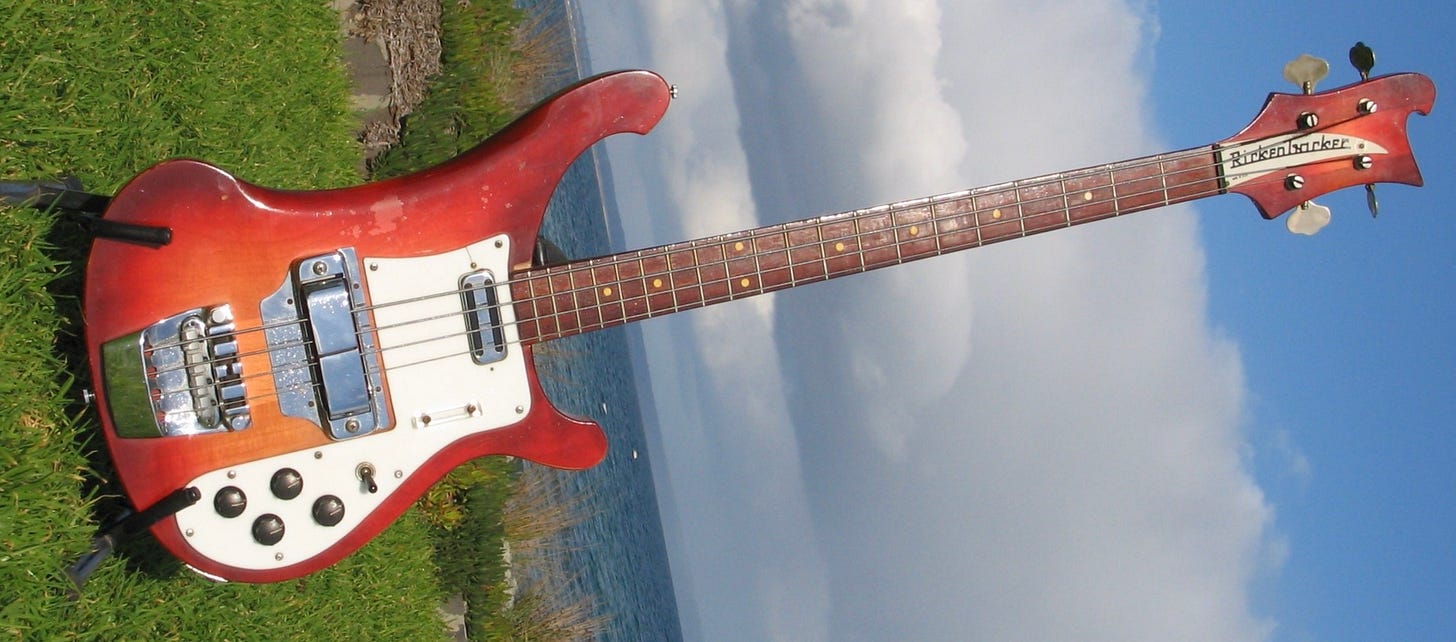
Most of the basses built in 1964–and indeed, a significant percentage of total 1964 production—were exported to the UK. In 1963 British distributor Rose-Morris had signed a deal with Rickenbacker and selected five models for import to the American guitar-hungry UK, including the 4001S. Filling those orders was the factory’s top priority.
Designated the Model 1999 by Rose-Morris, they only asked for one modification for the UK market: they wanted “MADE IN U.S.A” added to the truss rod cover. And so it was—below and parallel to the Rickenbacker logo—for the Rose Morris guitars and all Rickenbacker production.
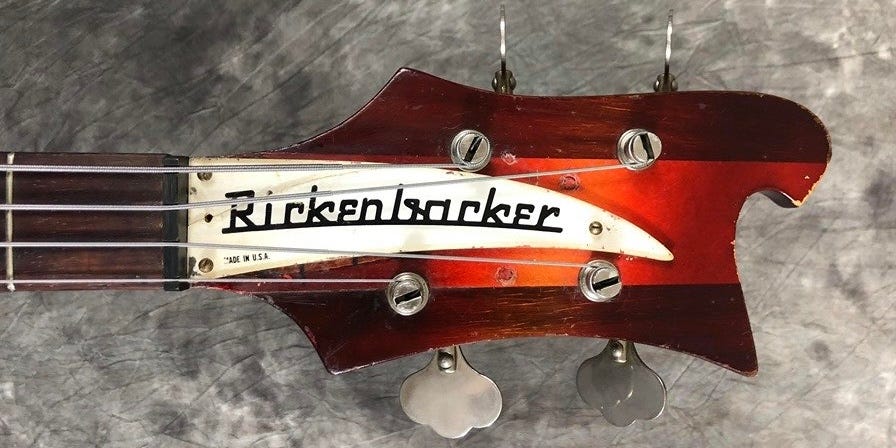
The Model 1999 quickly made its way into the hands of British Invasion bassists like The Who’s John Entwistle and The Kinks’s Pete Quaife. But the most famous of these 1964 4001S/1999 basses—the very first left-handed Rickenbacker bass—got turned down by its intended recipient the first time he saw it. But a year later, in 1965, he changed his mind and it went on to become his main guitar for a good long run.
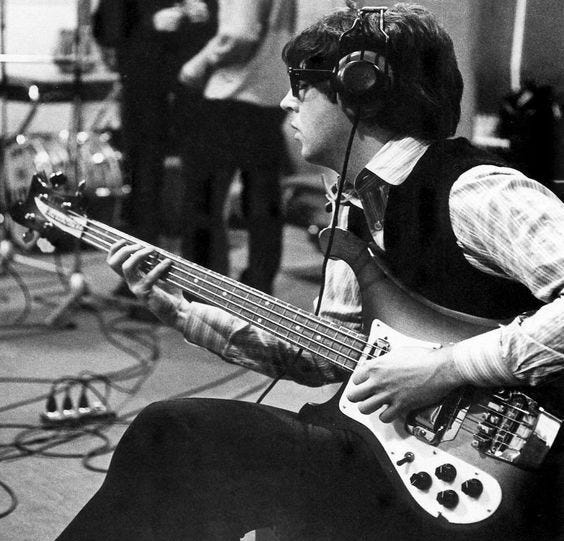
Mid-year, after the launch of the new “round top” 360, all Deluxe guitars—including the 4001–had their triangle inlays change from full-width poured resin triangles to crushed pearl triangles.
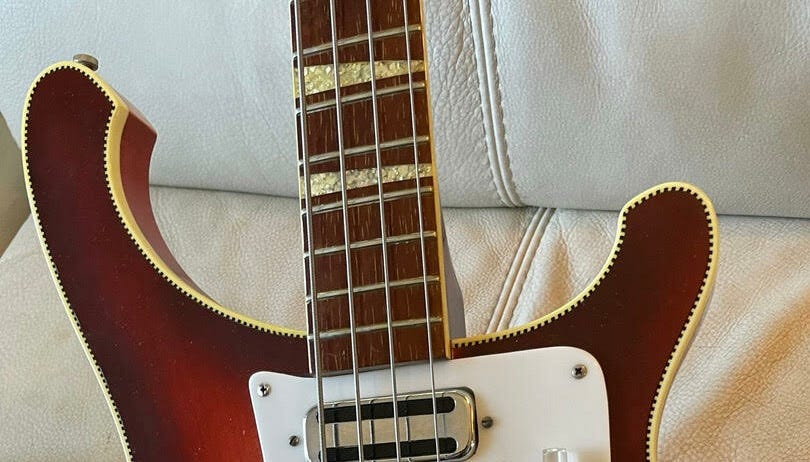
Around November, the knobs on the 4001–but NOT the 4001S/1999–transitioned from the old black KK “vintage” knobs to the plain silver-topped dials that had first appeared on the new “round-top” 360.
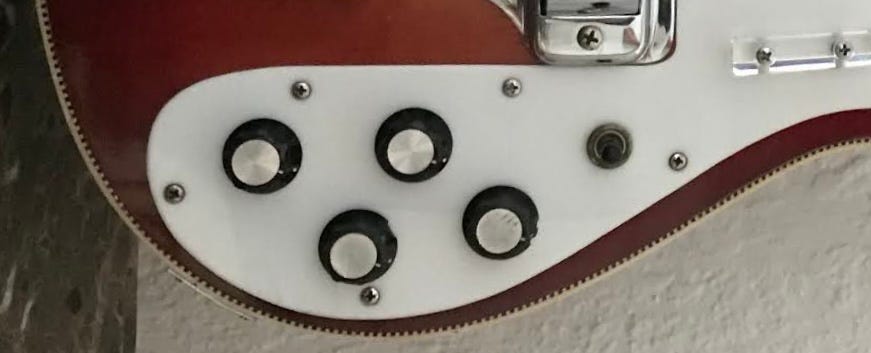
The keen eyed among you will have noticed at least two different horseshoe pickup surrounds. I wish it was that simple! Now is as good a time as any to discuss them, I suppose
There are multiple variations of the horseshoe pickup surround out there. And I haven’t found consensus language out there to describe them! So we’re going to have to make some up. The very first 1963 4001s had pickup surrounds with a square-cornered top and a short tapered tail (thanks to Ron O’Keefe for that term!) on the bottom, like so:

Later that year, the top corners would get extremely rounded over, like so:

I think the tail is a little different too, but I can’t quite put why into words. And then in 1964 you can find examples like the above, but not quite so rounded over:

Then, later in the year, a long tapered tail enters the mix:

And here’s the thing: you’ll find all of these—and more subtle variations—through 1968. Some had patent information stamped on the tail, and some didn’t. Corner shapes varied, as did tail countours and lengths. If there’s a pattern, if there’s a timeline…I just can’t find it. So we’re going to say they’re ALL correct, and we’re not going to talk about pickup surrounds again until 1968 when there is a significant change.
I will say, however, that almost all 1967 guitars have the long tapered tail. So there’s that!
1965-1967
Thanks to the 1964 Ed Sullivan Show appearances of that 1958 325 we talked about at the very beginning and the starring role of a certain 1963 360/12 in a blockbuster movie, the factory got pretty busy churning out guitars in 1965, and not many basses were built over the next few years.
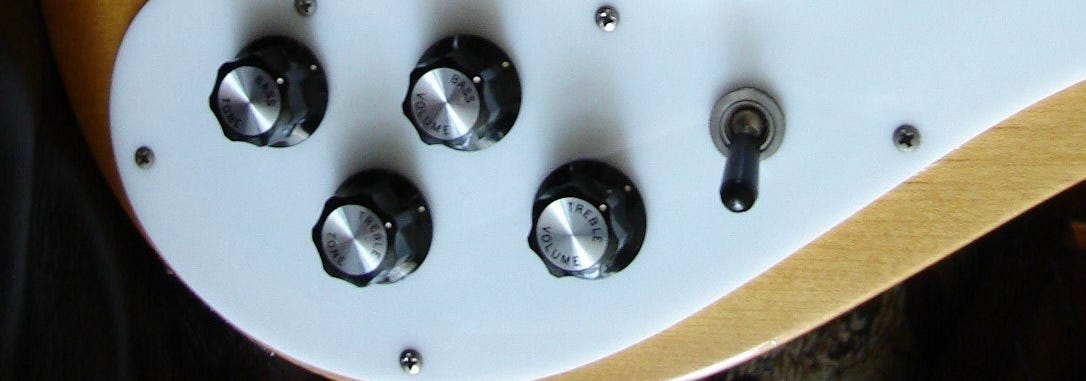
The only change of note over this period was that both the 4001 and 4001S received the labeled silver-top knobs.
1968
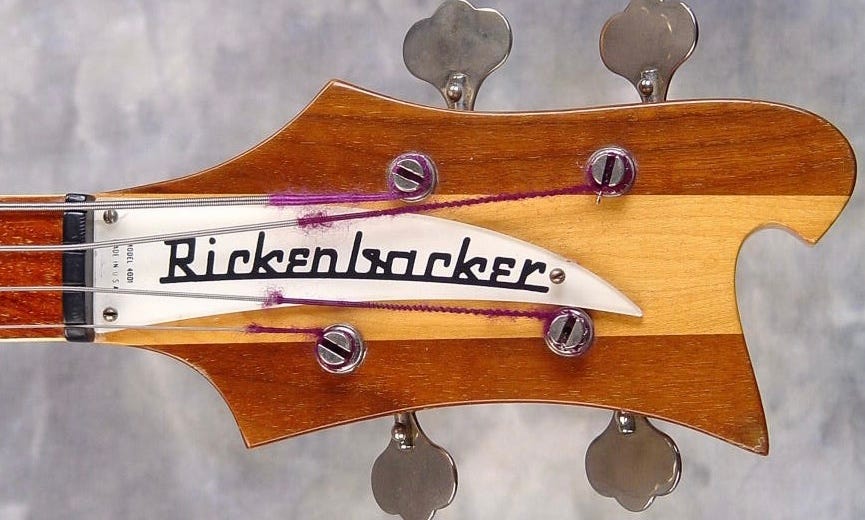
Around April a change to the truss rod cover began rolling out across the entire line. The “MADE IN U.S.A.” marking that had been below and parallel to the Rickenbacker logo shrunk and moved to the bottom of the TRC just above the nut, perpendicular to the logo. For higher volume models like the 4001, the model number was printed just above that—although not all 4001s from this era will have this cover. If they ran out of the model-specific covers they’d just grab a generic one!
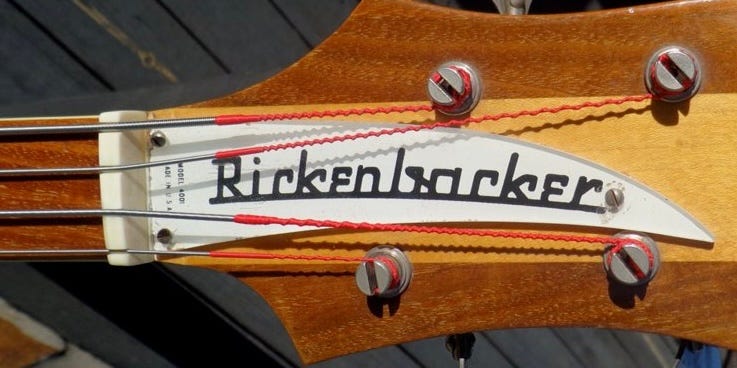
Around June the black phenolic nut would change to white—although you would see both until early 1969 when it standardized on the white.
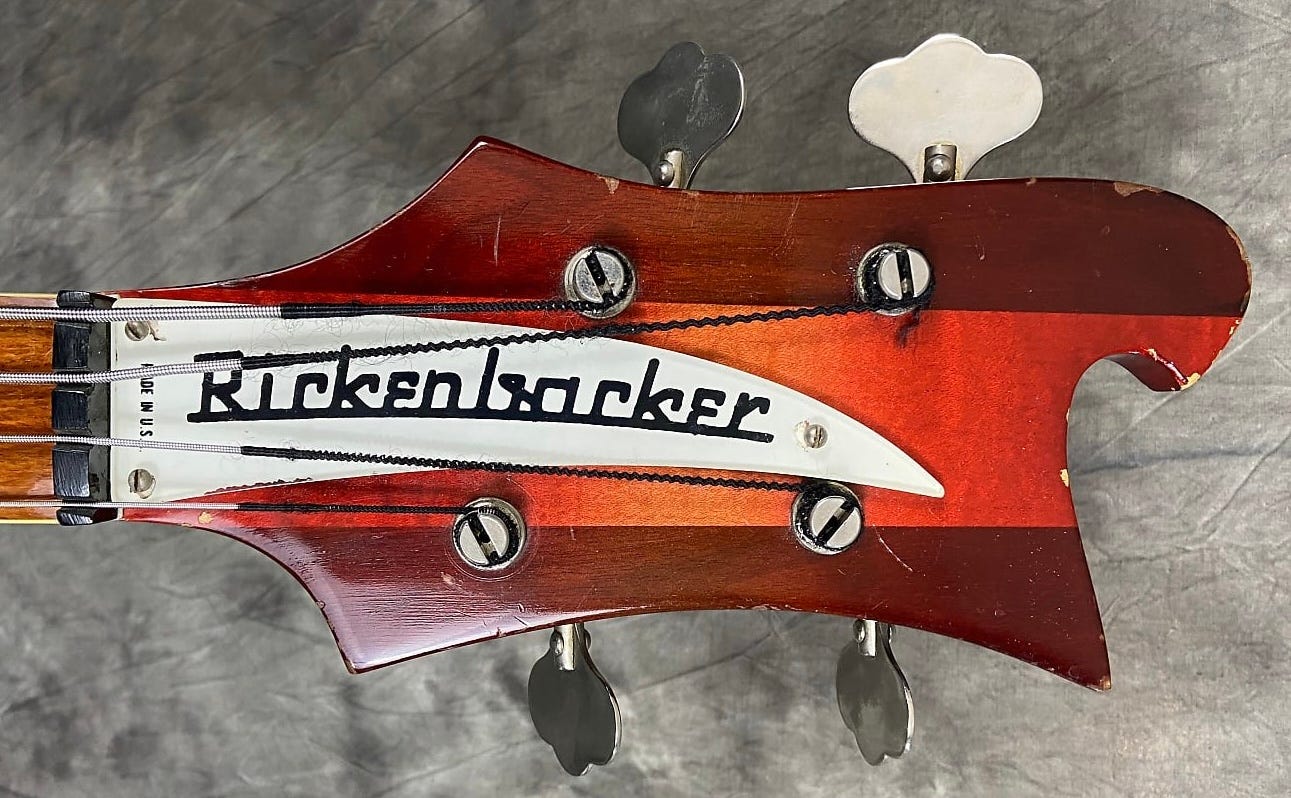
The April change to the truss rod cover would be short-lived. By October the “MODEL 4001” stamp disappeared, leaving just the “MADE IN U.S.A.” stamp above the nut.
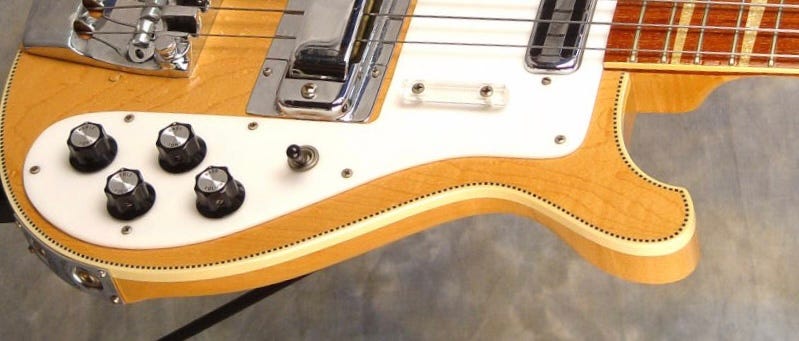
As near as I can tell the first Ric-O-Sound equipped 4001 appeared in mid 1968, although the stereo wiring would only be an option until it become standard until early 1970.
The most notable change of 1968, however, occurred in December when the bridge horseshoe pickup was replaced with the very first Rickenbacker Higain pickup. Lap steels would also get Higains around the same time, ending the 36 year run of Rickenbacker’s first—and indeed the world’s!—electric guitar pickup.
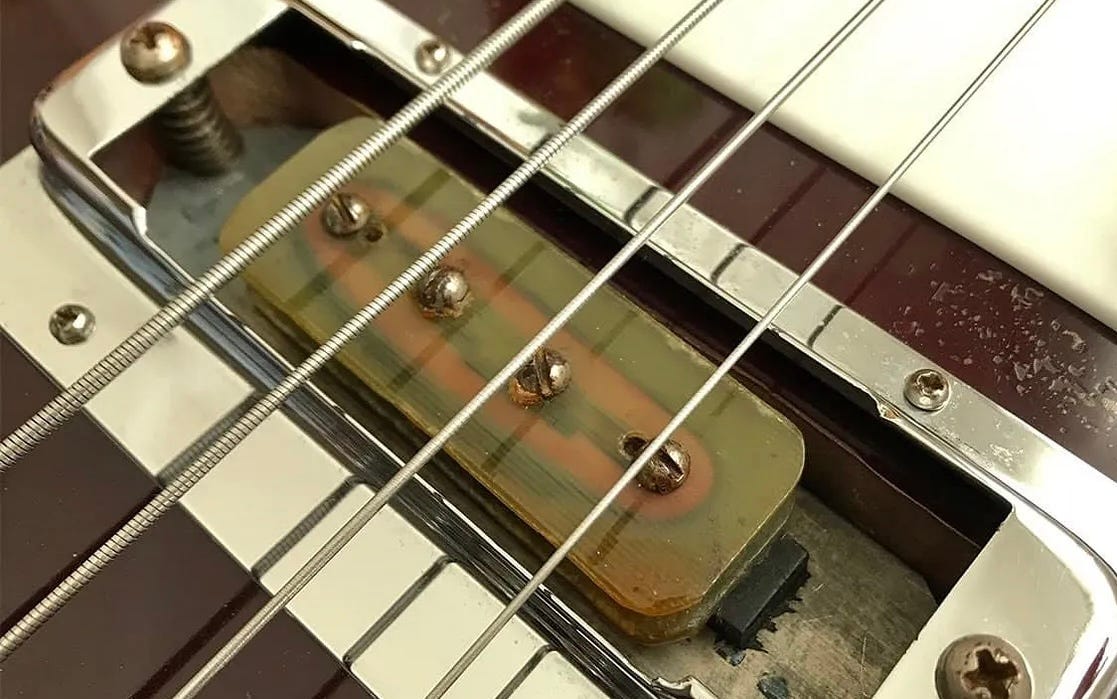
These first generation Higains had unpainted translucent white/greenish PCB bobbins with dome-topped flat head screw polepieces and an aluminum baseplate. Despite appearances these polepieces were not adjustable, and more than a few of these first Higains have been damaged or destroyed by people who didn’t know better.
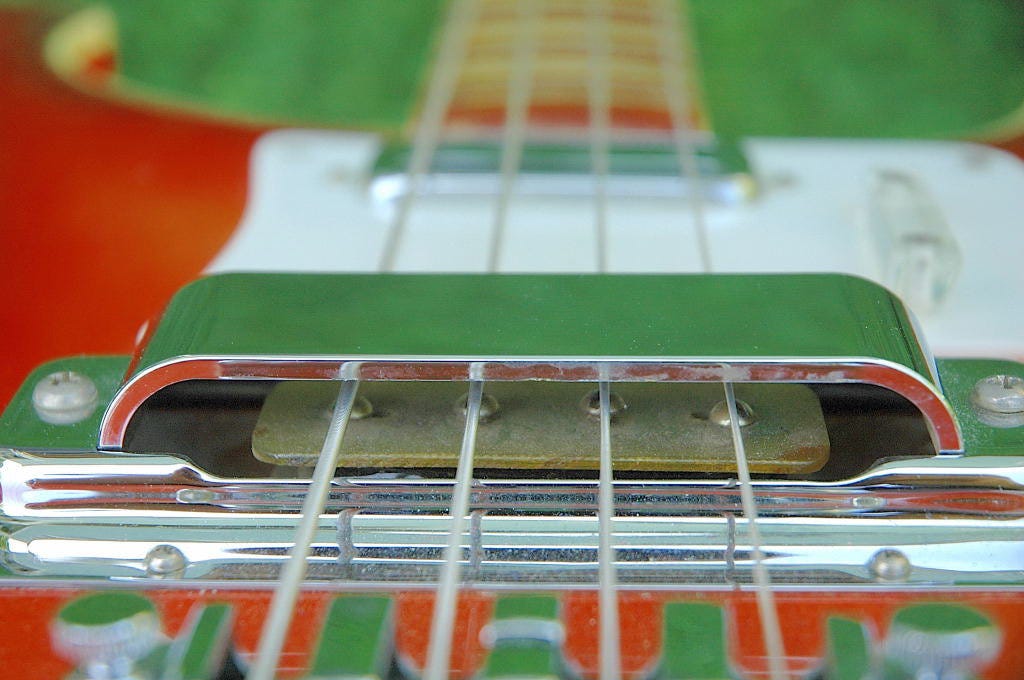
So why the pickup cover on the new Higain pickup? The horseshoe magnets served a purpose, but the cover? Well, despite being made of plastic these original units did have copper/nickel/chrome plating and did provide some noise shielding. But mostly I’m guessing it was cosmetic—that’s just how Rickenbacker basses “looked”!
Now, Rickenbacker being Rickenbacker you will find some early 1969 4001s with horseshoe pickups, but the Higain was now the default bridge pickup.
Along with the new pickup came a new pickup surround—although many of the last horseshoe-equipped 4001s also wore this new surround. It lost its tapered tail and got a squared off bottom like the top, but like the old tapered tail type you will find multiple versions. The first had extremely “pointy” corners:
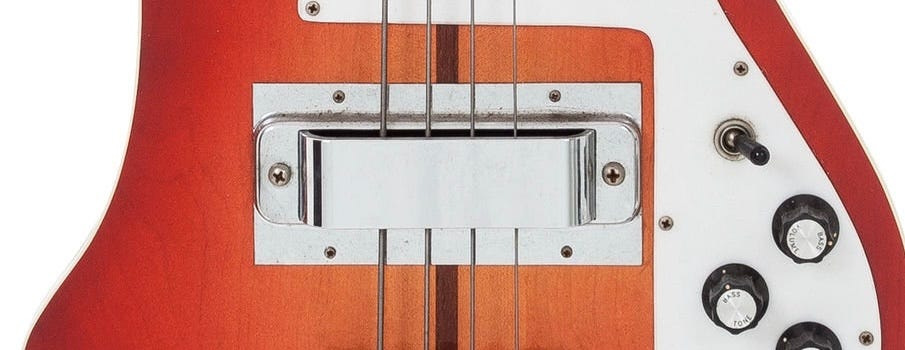
Another had more rounded corners:
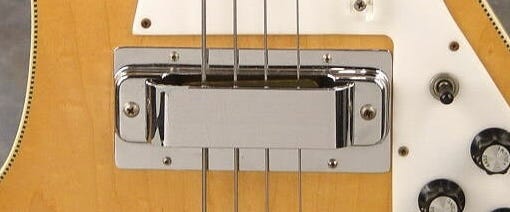
Yet another had quite rounded corners:
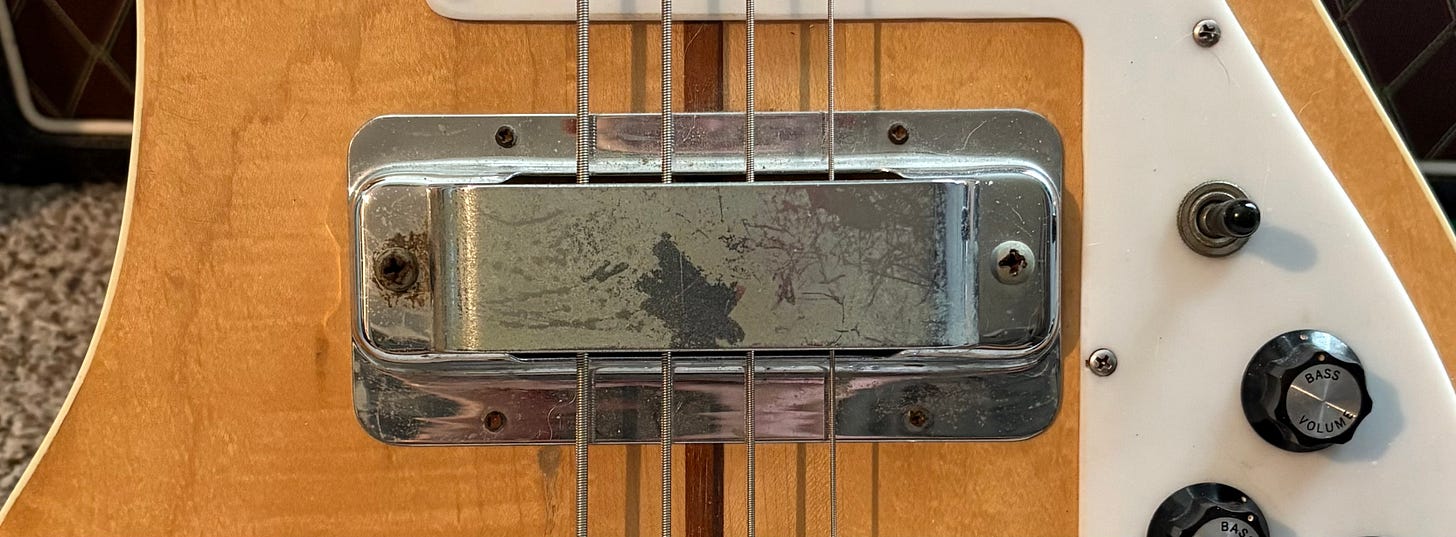
If there is a timeline or a pattern…I can’t find it. To further complicate matters, there’s another feature that differed: scalloped, or non-scalloped? Here’s a scalloped example:
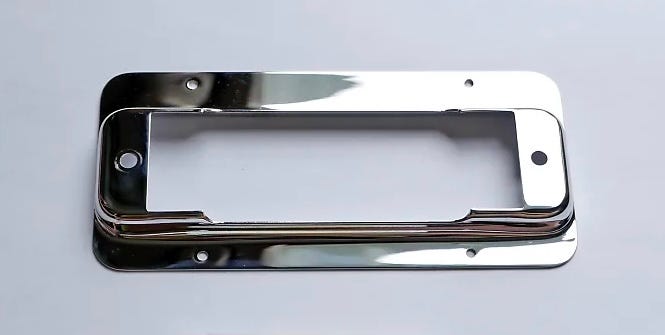
And here’s a non-scalloped:
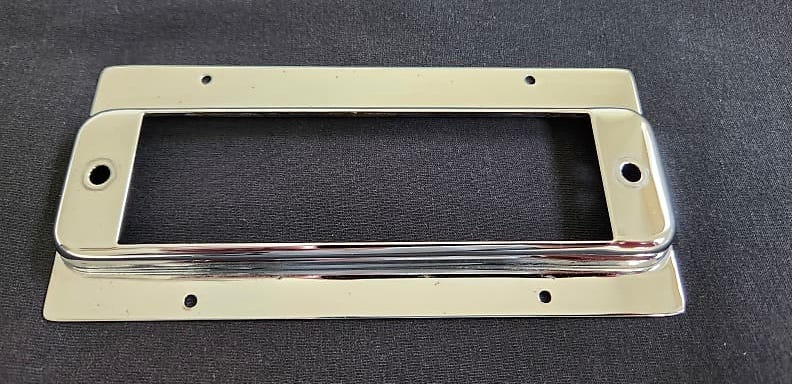
Notice on the top picture how there’s a scoop cut out where the strings pass through, and on the bottom picture…there isn’t. That’s the scallop. They come longer and shorter, and deeper and shallower than the example above. Again, if there’s a pattern or a date range…I can’t find it.
But by 1973 they seem to have standardized around a non-scalloped, rounded corner version as seen below.
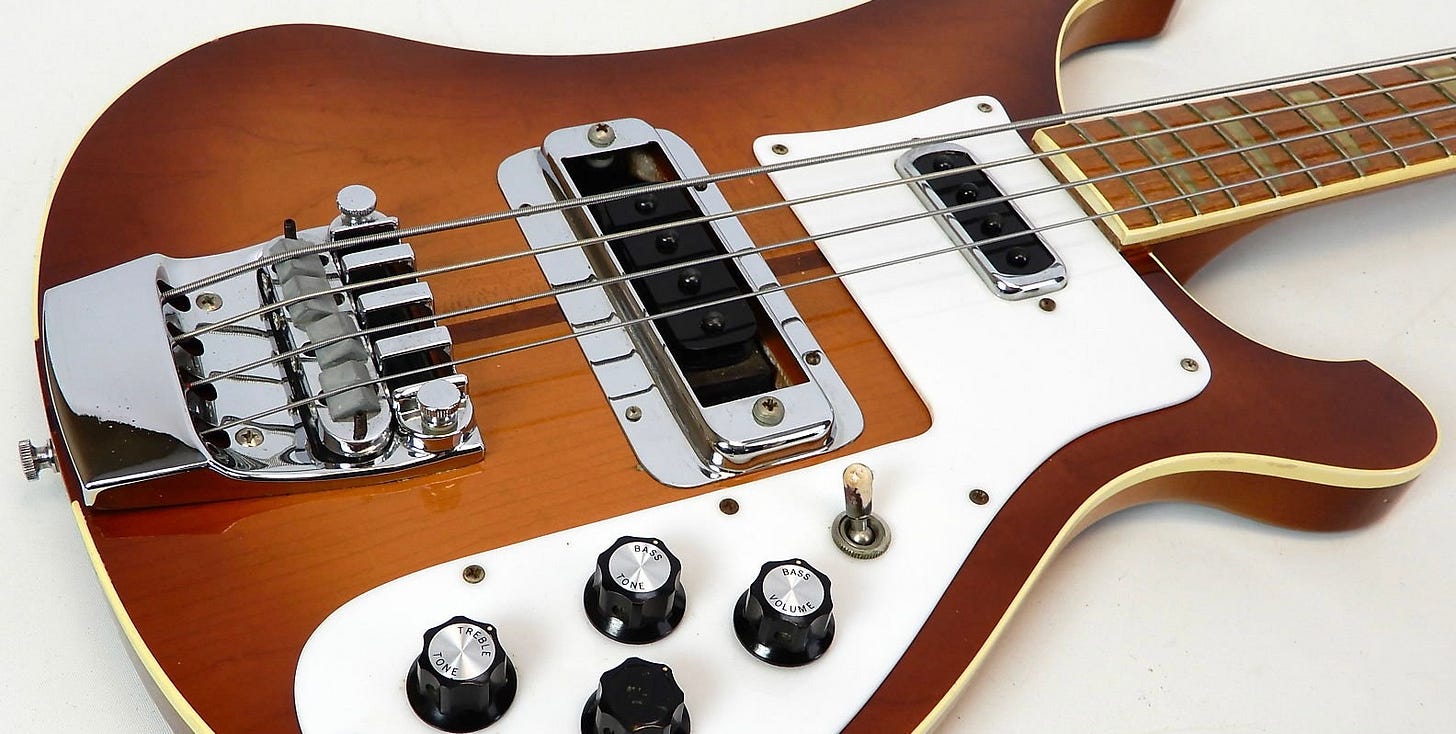
1969
Around May the Kluson 538 tuners in use since about 1963 were replaced with Grover Slimline bass tuners with “flat” keys. Apart from the flat keys, these tuners are identical to the infamous “wavy” Grovers that would replace them.
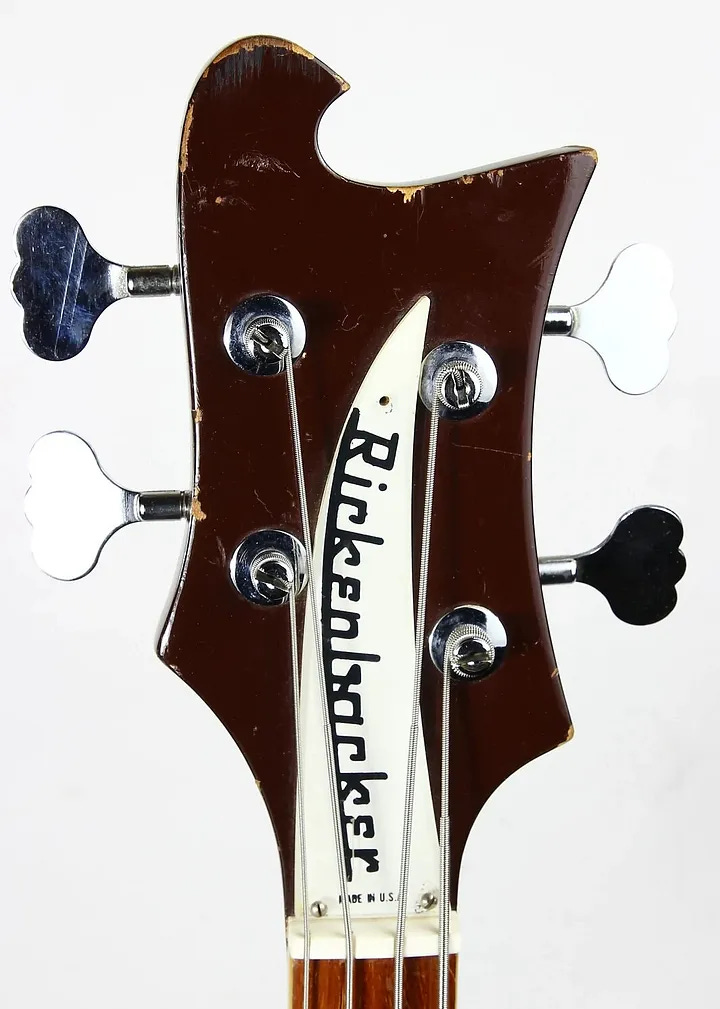
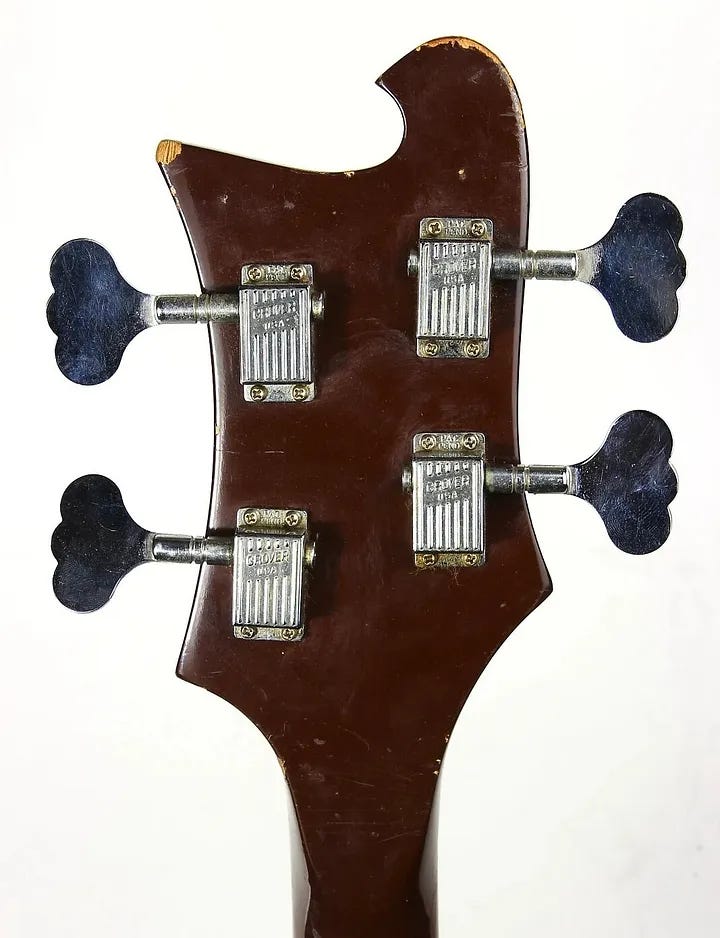
In mid 1969 the pickguard began to shrink. Whereas before the bottom of the upper part of the guard touched/almost touched the pickup surround, the new shorter version left an almost 3/4” gap between.
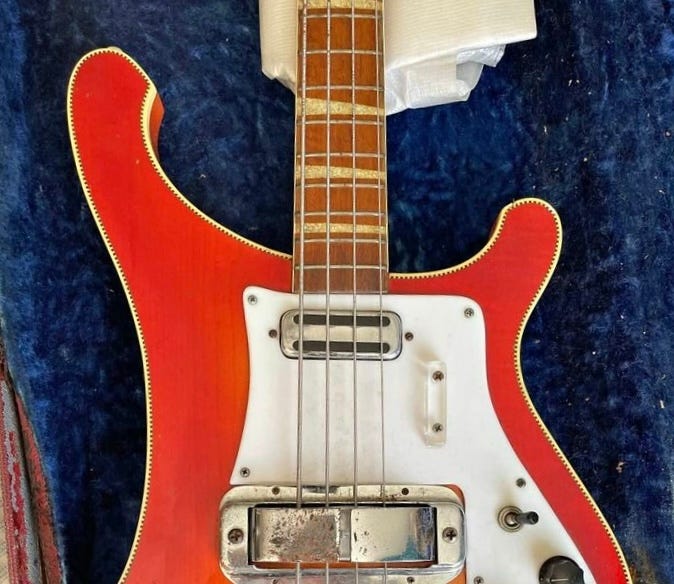
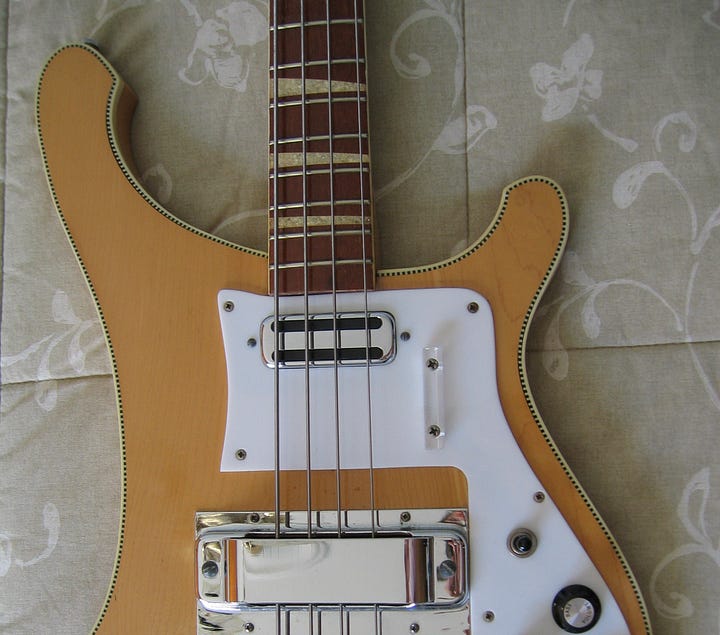
The pickguard length would fluctuate some for the next year or so before settling down to the shorter length.
Around October an odd variation of the 4001 appeared: a 21-fret version.
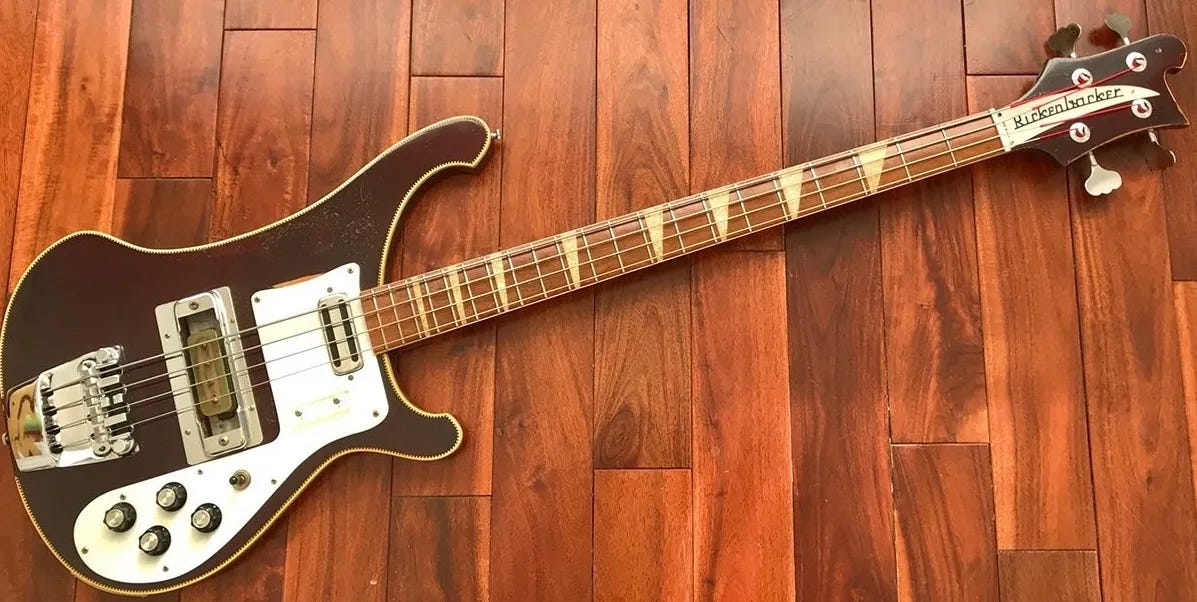
The 21-fret version maintained a standard 33.25” scale. This was accomplished by slightly lengthening the fingerboard, and sliding the bridge slightly upward to compensate. Although the fingerboard was longer, the neck blank wasn’t. As a result, the headstock was shortened about half an inch.
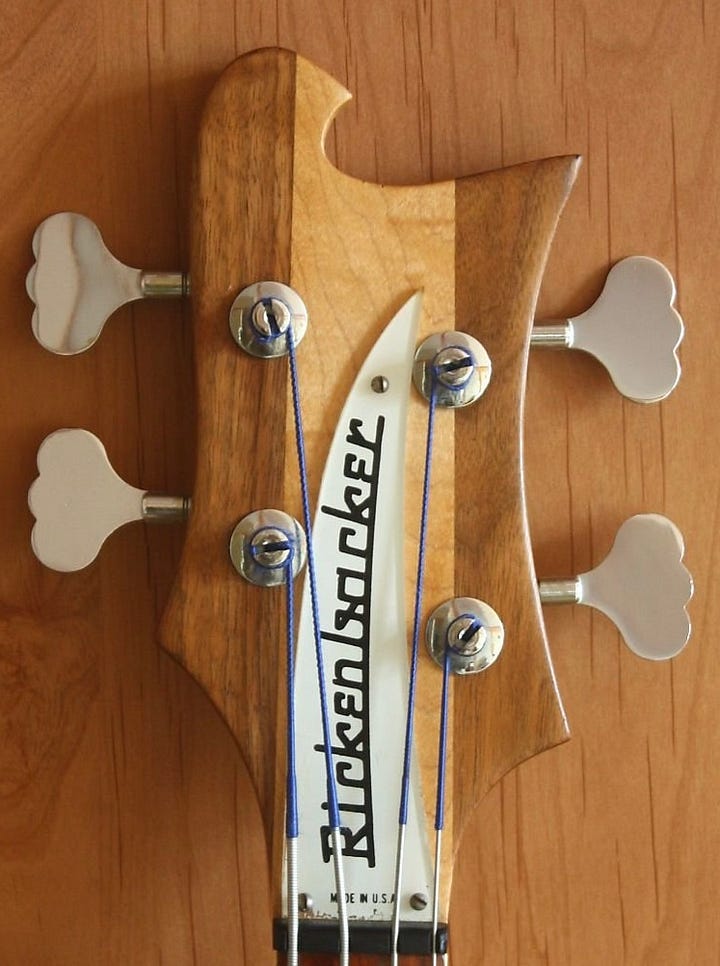
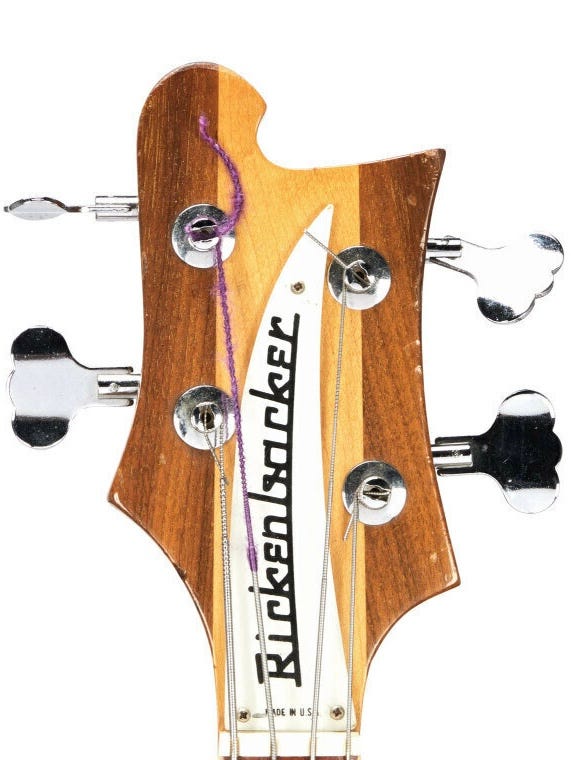
This 21 fret version was made alongside the “standard” 20 fret version through early 1971.
1970
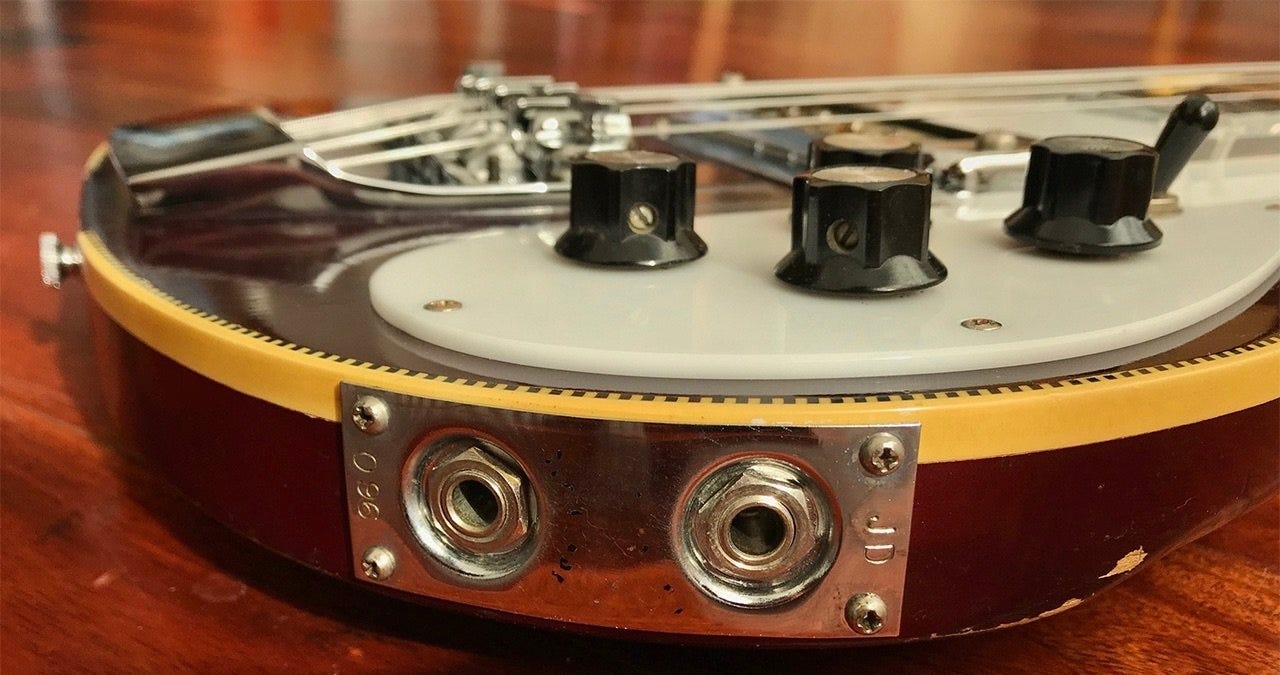
In early 1970, Ric-O-Sound stereo wiring became standard on all 4001 basses. It had been optional since 1968. The 4001S remained mono only.
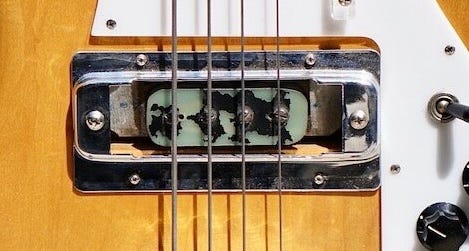
While I can’t nail down exactly when it happened, by the end of 1970 the bobbin of the bridge Higain pickup gained a coat of black paint—although as the photo above shows it is quite prone to wear!
1971

In January 1971 the “short” headstock that had first appeared on the 21-fret 4001 became standard on the 20-fret version as well.
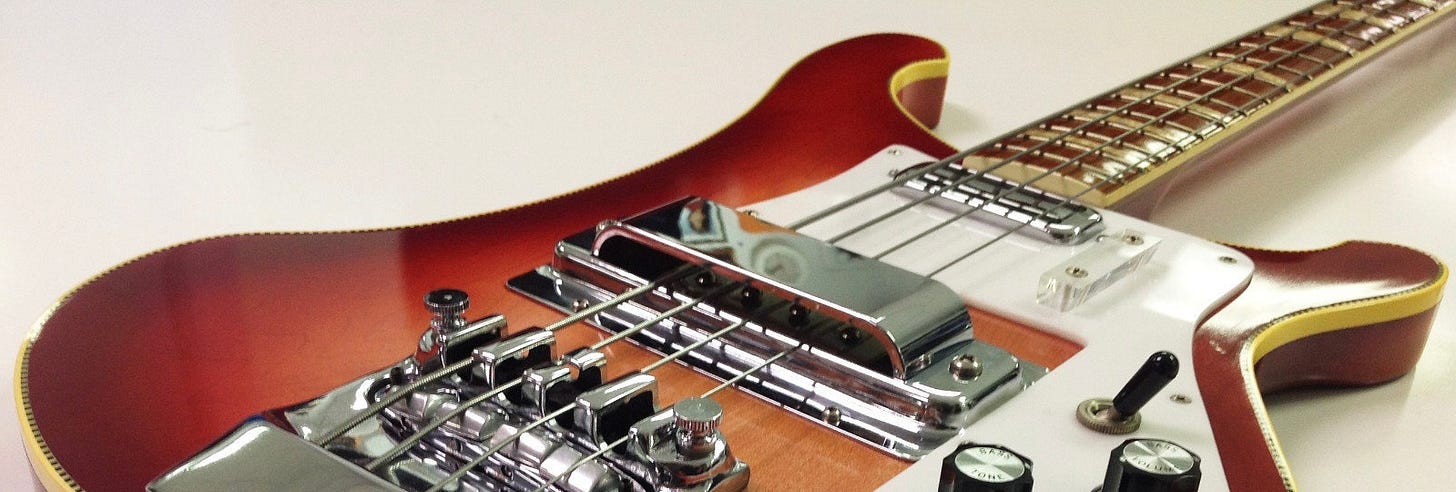
At the same time, the bottom of the fingerboard gained binding for the first time—except on the 21 fret examples, which would end production towards the end of February.
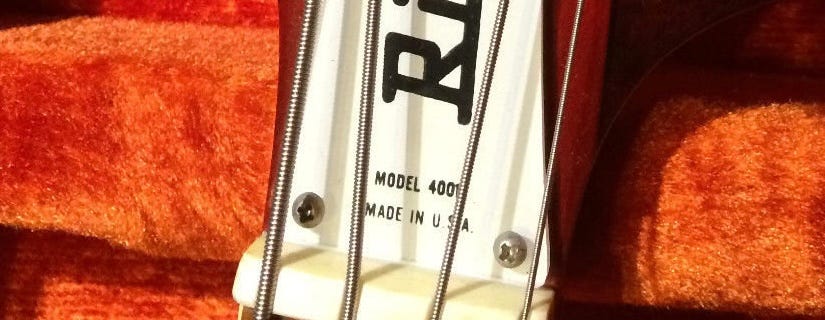
Early in the year “MODEL 4001” would return to the truss rod cover. Unlike the 1968 version, however, it would appear above the “MADE IN U.S.A.” stamp instead of below. Just like on the earlier version, you will find factory installed model-less truss rod covers during this era.
1972

March saw the first substantial construction change to the 4001 since its introduction in 1961 with the birth of the skunk stripe! The through neck changed from one piece maple to a three piece maple/shedua/maple sandwich. At the same time the headstock wings changed from walnut to maple.
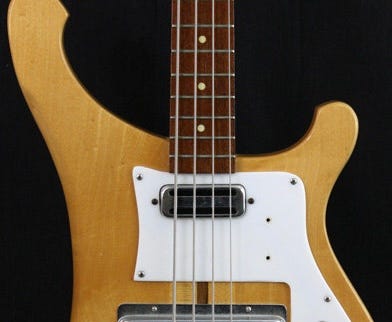
In addition to the skunk stripe, the 4001S also gained a 19th fret position marker.
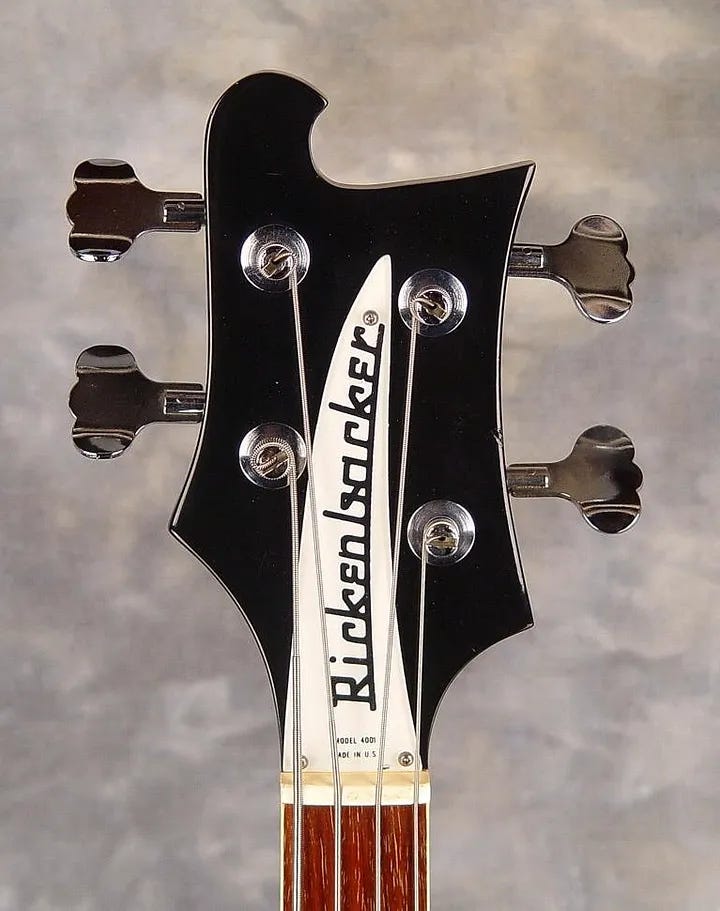
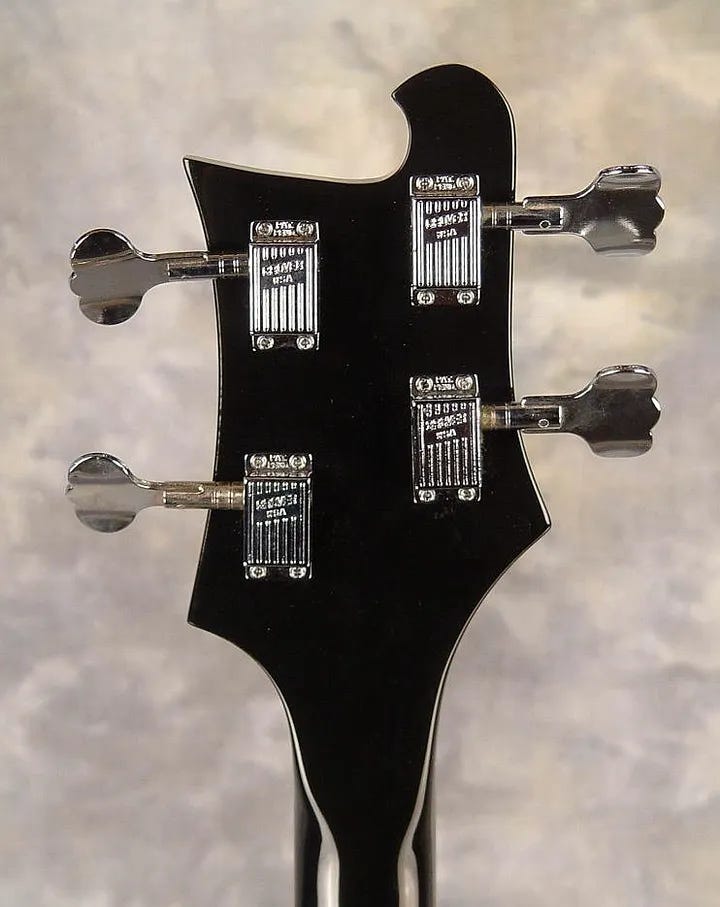
Around June/July the infamous “wavy” Grovers appeared. Put simply, the “ears” of the tuning keys got bent slightly in opposite directions, transforming the keys from flat stamped units to a “wavy” or “S” shape.
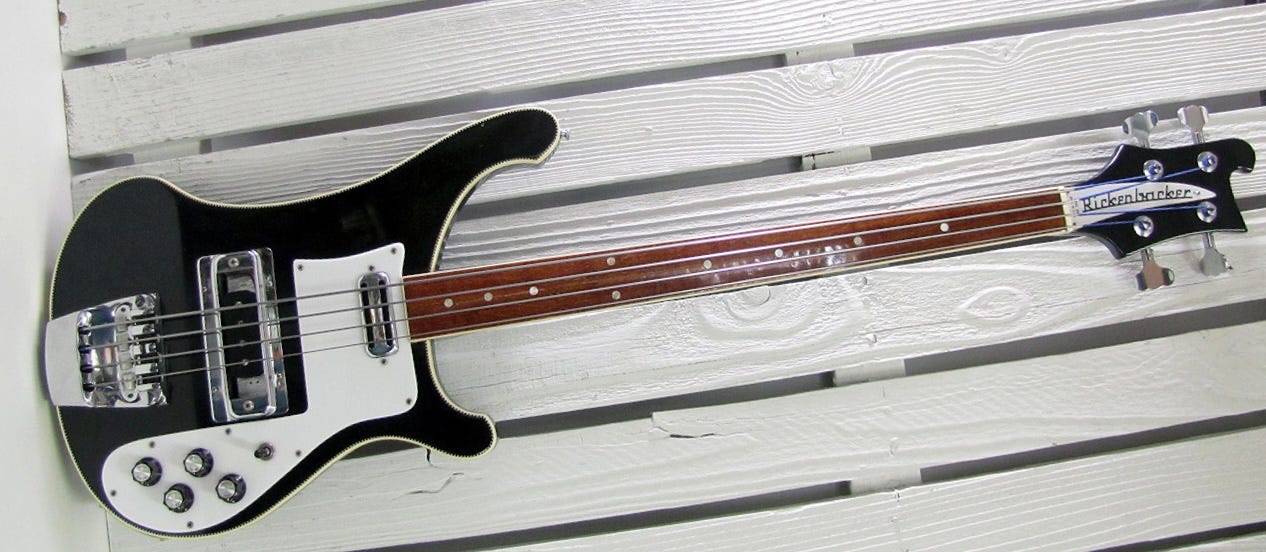
A fretless version of the 4001 debuted late in the year—which I bet is earlier in the timeline than you expected! It was identical to its fretted brother apart from the lack of frets and the fact that it featured large pearlescent dot inlays instead of triangles.
At the end of November, the clear plastic “tug bar” was deleted—nobody had ever actually used it anyway!
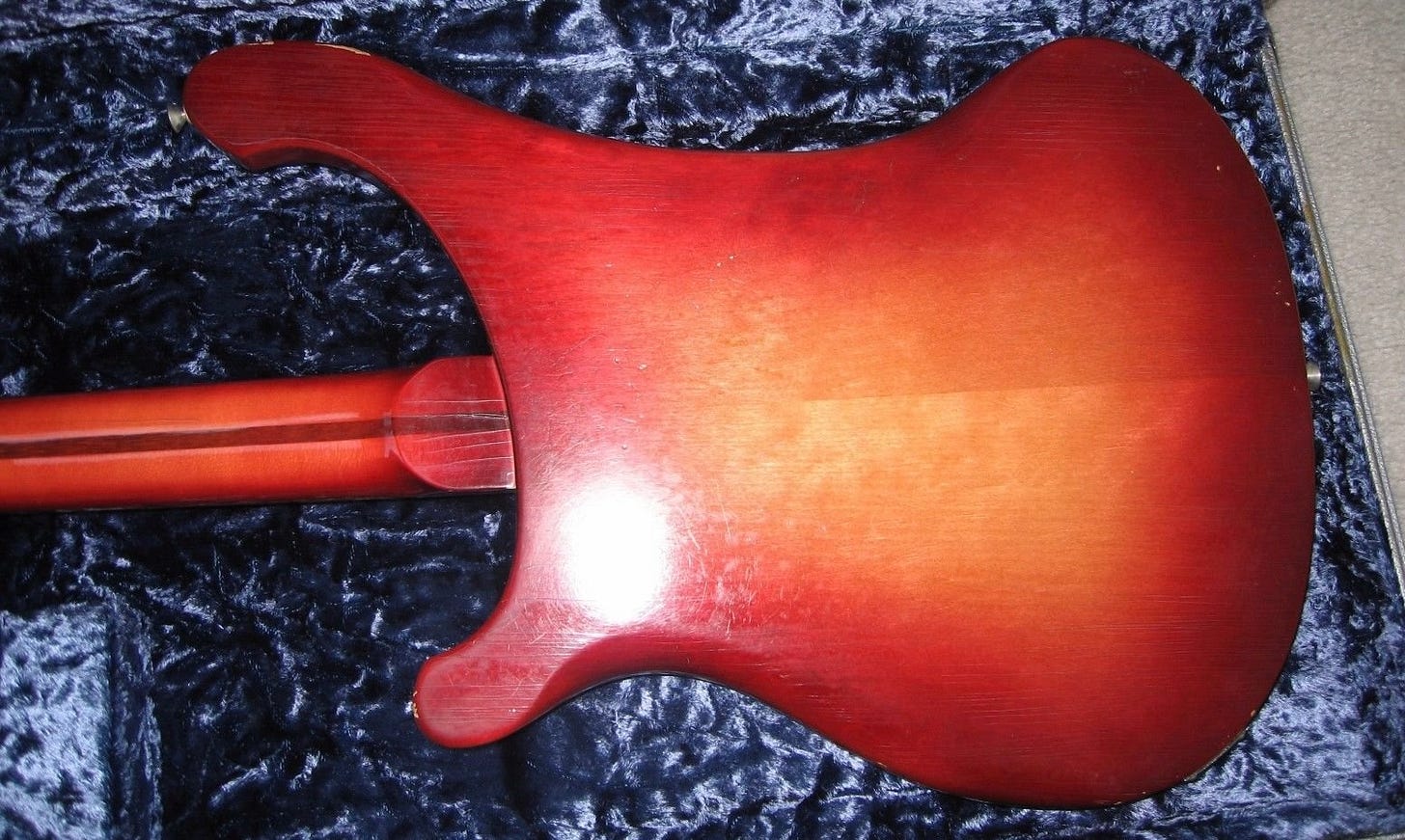
Along with the 4000 bass, in December construction of the 4001S began the transition from neck-through to set neck. Without the center neck-through section as an integral part of the body, the new body itself was two-piece center seamed maple.
1973
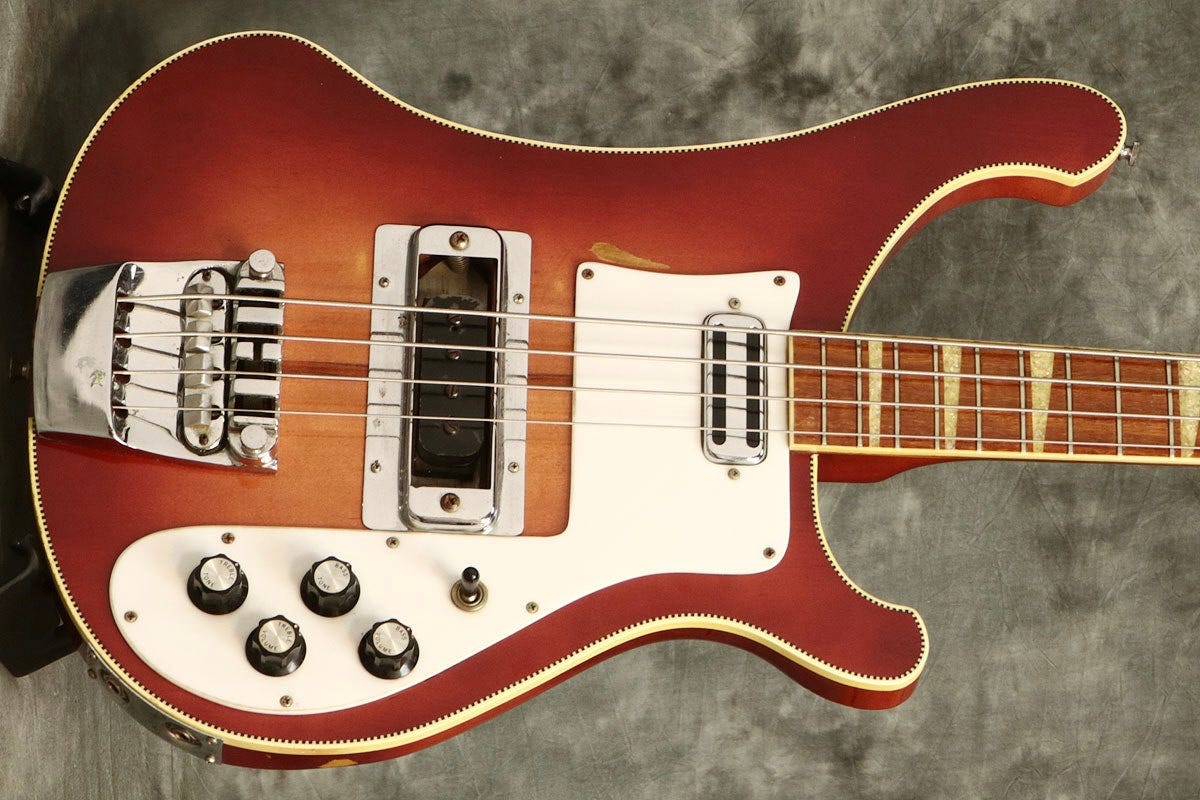
So in terms of spec changes, 1973 is hands down the most important year for the 4001. So much so that collectors refer to 4001s as “pre ‘73” and “post ‘73”. At the beginning of the year, the 4001 had (mostly) vintage appointments. By the end of the year…the vintage era had ended and the modern era had begun.
In March, the full width crushed pearl triangle inlays were replaced with full width poured pearlescent resin triangle inlays…
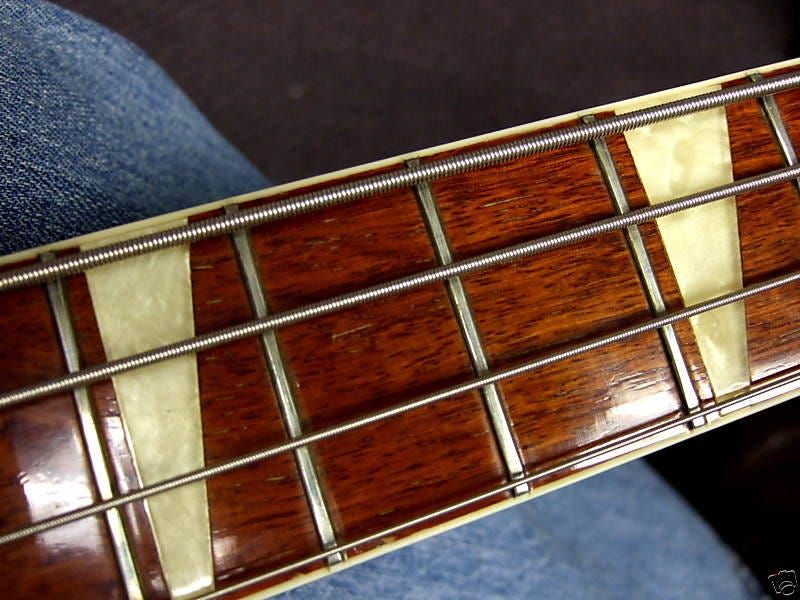
…but those would not last long. By the end of April/early May, they were replaced by inset poured pearlescent resin triangle inlays.
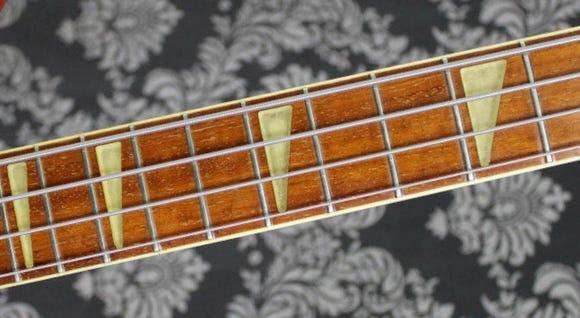
Around May, the chrome-plated cast aluminum bridge with its “gap tooth” was replaced by a chrome-plated cast zinc bridge. While the overall design is the same, it is easy to spot the difference between the two. The zinc bridge lacks the “gap tooth” between the A and D strings, and two additional mounting screws were added behind the drop-in bridge.
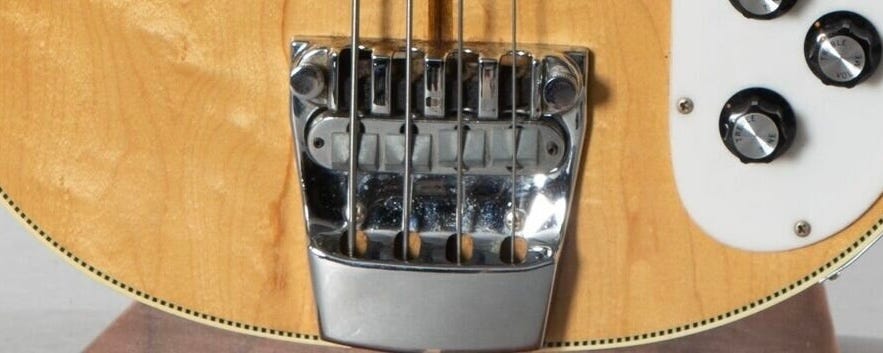
In late May/early June, the nut reverted to a black phenolic material.
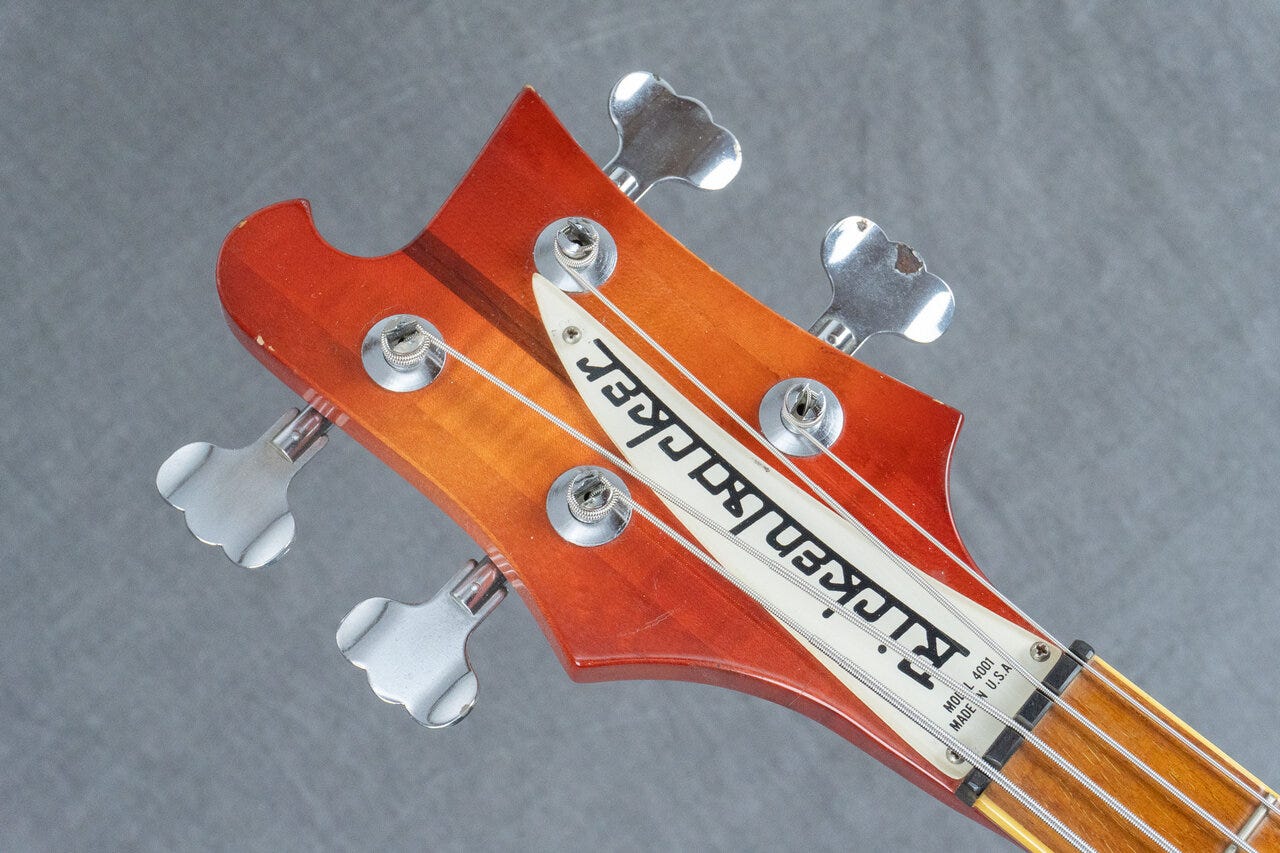
In July, the polepieces on the black painted bridge Higain would change to button top drive screws, also painted black.
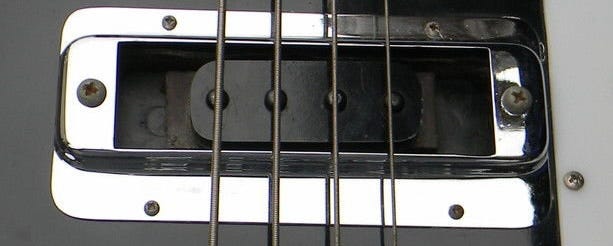
Also in July, the multi-ply binding with a checked inner layer went to single-ply white binding.
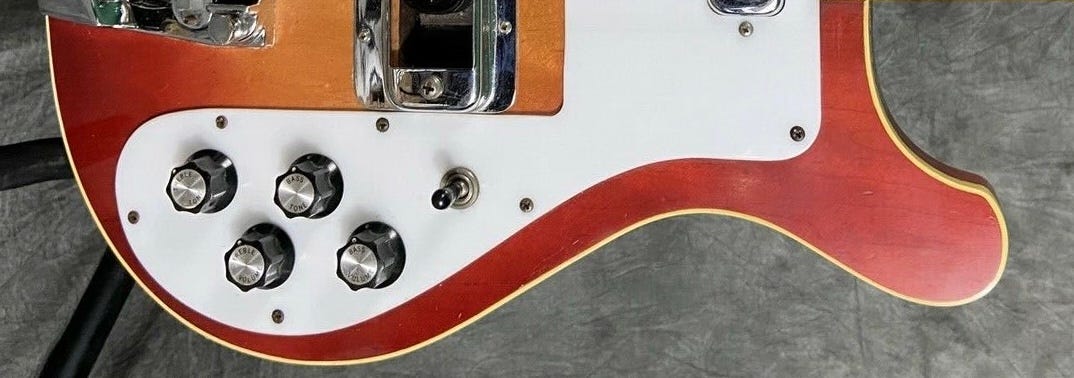
And in September, the neck toaster pickup was replaced by a black painted button-top Higain. There was only one “vintage” specification left: the neck pickup location.
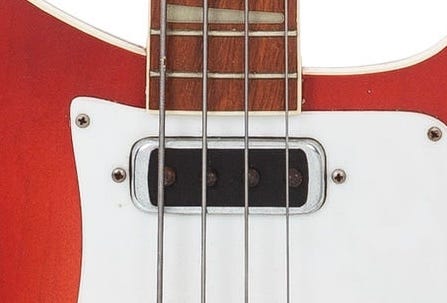
Two identical prototype 8-string basses dubbed the 4001/8 were built in 1973.
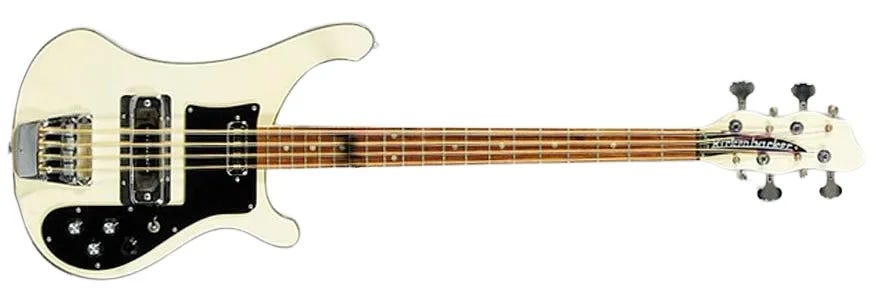
Black-trimmed before the “Black Trim” era officially started, a few other modifications were made to the existing 4001 to accommodate the four extra strings. First, the 4001/8 got the “potato head” headstock that had first appeared on the 4005/8.
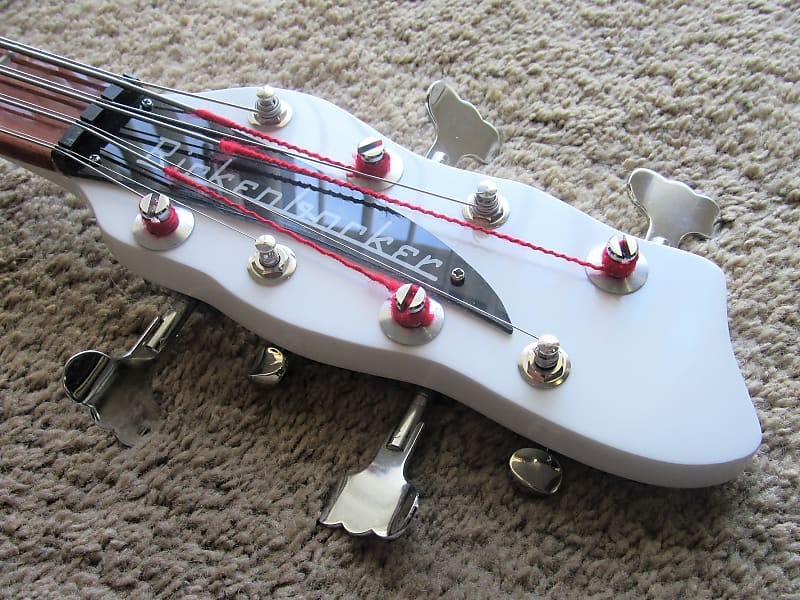
While good photos are hard to find, it appears that the “teeth” over the string mute were removed as they would be on the later production 4003/8, and an 8-polepiece bridge Higain MAY have been produced. The guitars also, unusually, had dot inlays.
The two guitars would be given to Chris Squire and John Entwistle. While the model would later appear on the 1975 pricelist, it was vaporware. No more would be produced.
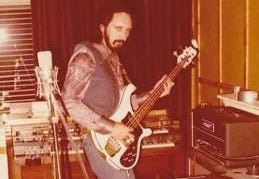
1974
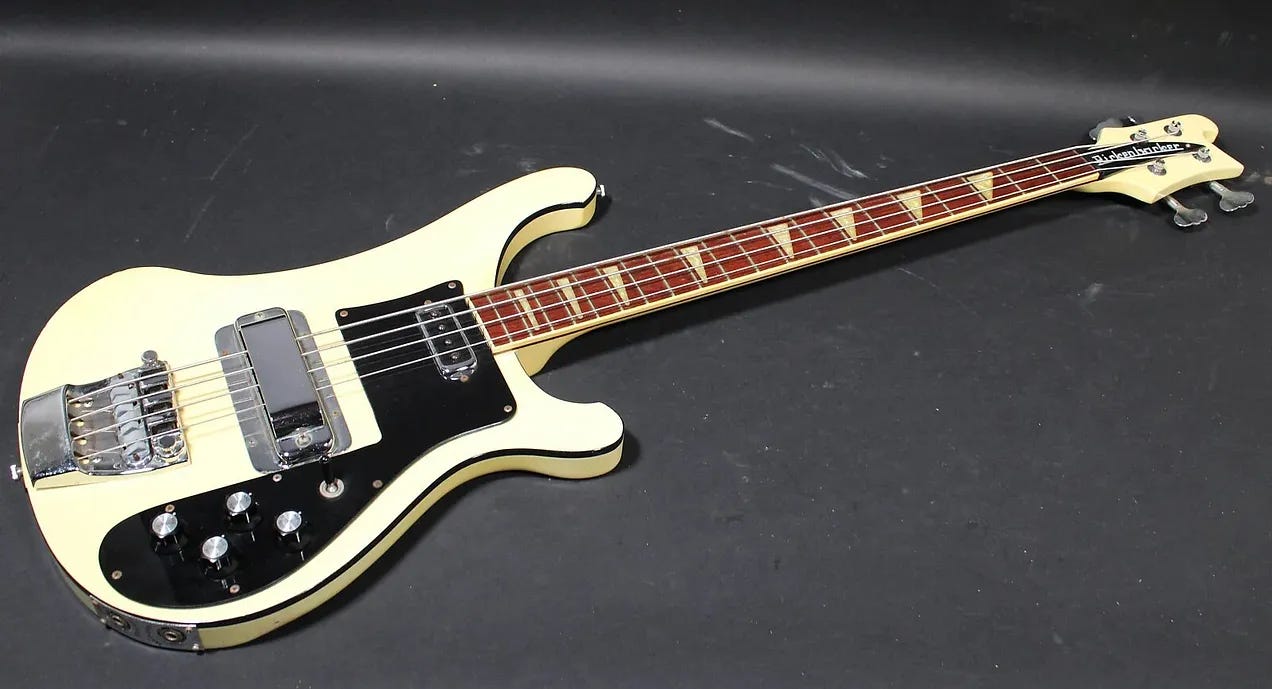
The “Black Trim” era officially began in early 1974. White 4001s were fitted with black body binding, black pickguard, and a black backpainted plexiglass truss rod cover. Oddly enough, the neck binding remained white. Unlike the 1980s/90s “BH/BT” era, the hardware was not blacked out—it remained chrome/nickel. For 1974, White was the only color offered with black trim.
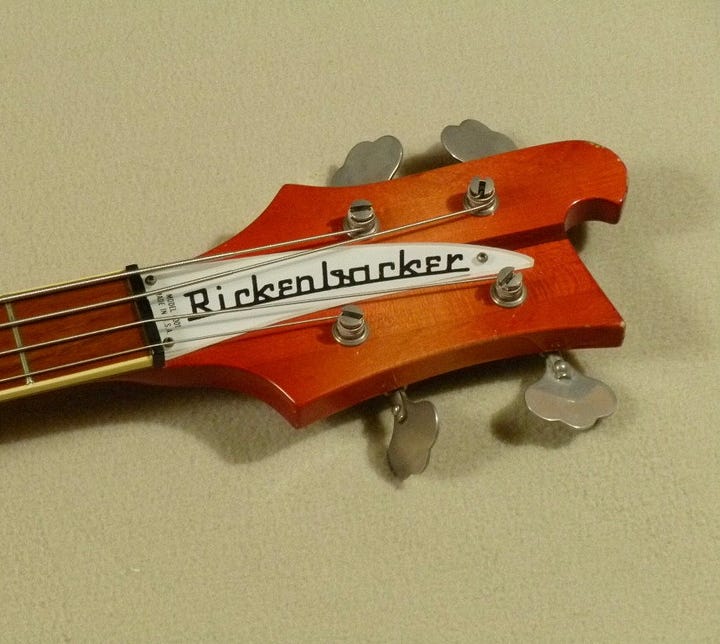
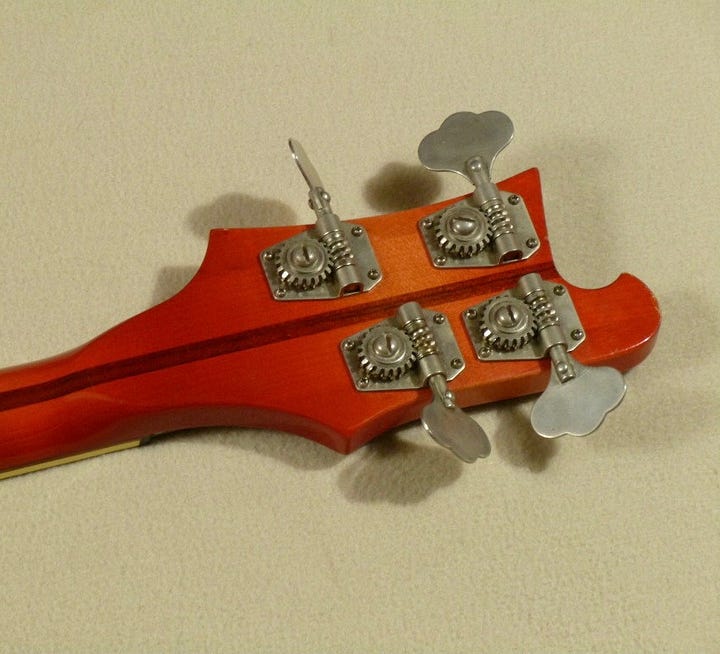
Around June/July the “wavy” Grover Slimline tuners were replaced by the very same open back Kluson 538 tuners the Grovers had replaced in 1969.
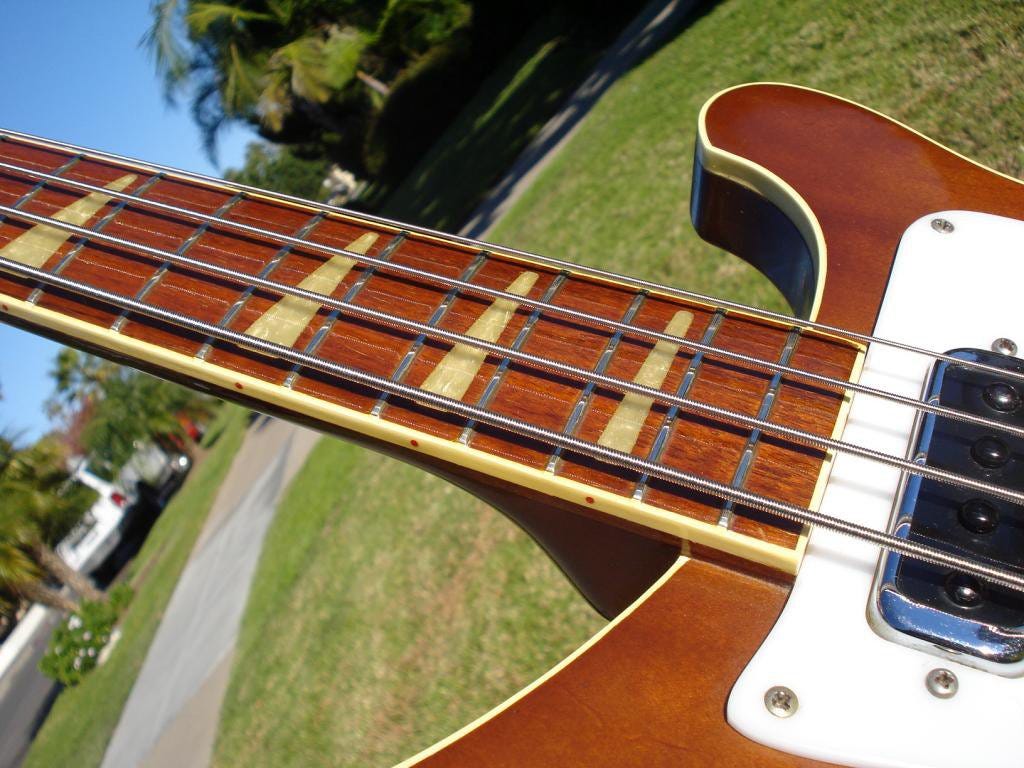
From mid June to late July—although other examples may exist—the 4001 featured red side dots instead of the normal black. The common belief is that they “ran out” of the black and used whatever was handy.
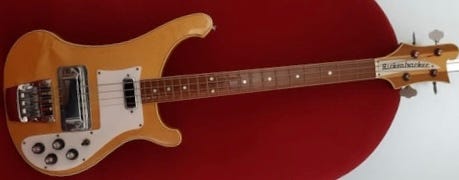
A “handful” of short scale 4001s—designated the 4001SS in factory shipping records—were produced in December. These odd instruments featured a 30” scale, a bound headstock with walnut wings, no skunk stripe on the through neck, dot inlays, and checkered binding.
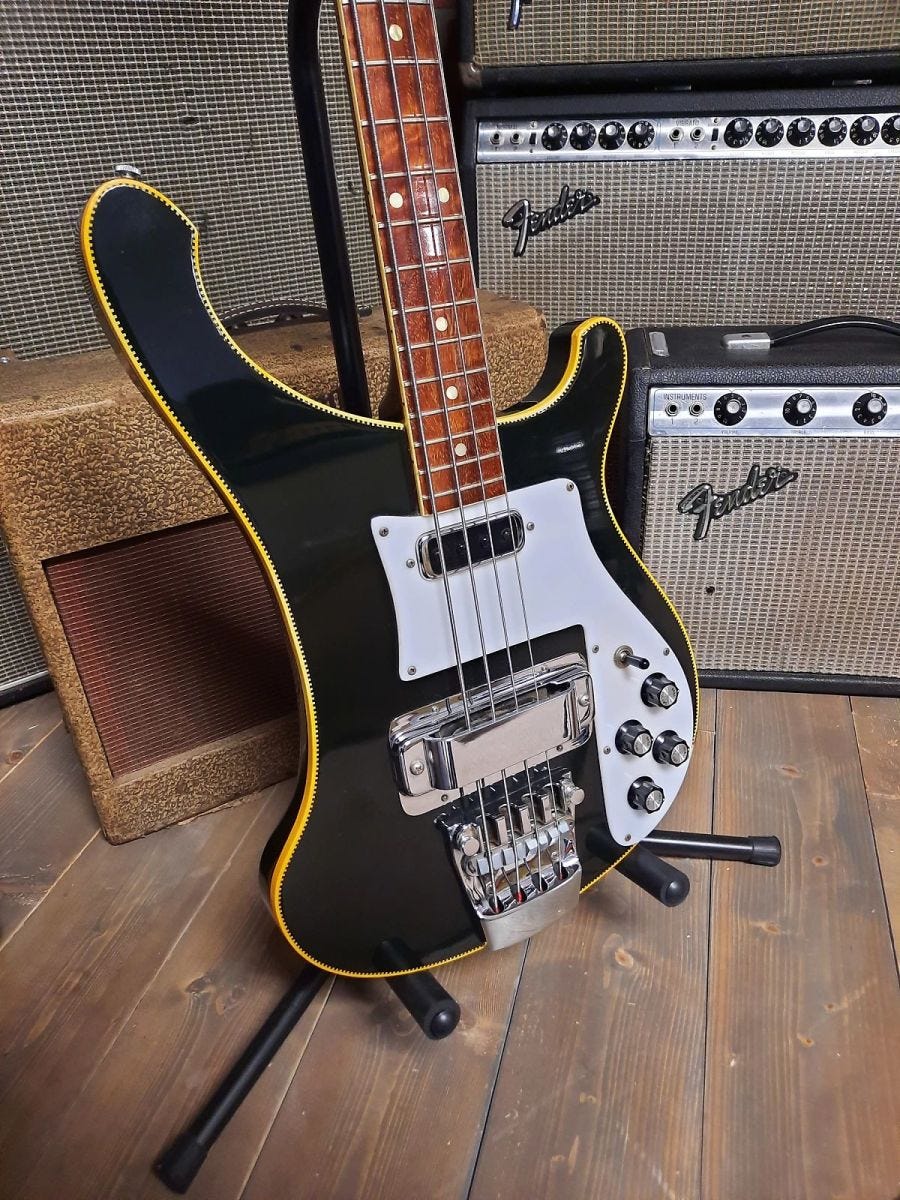
1975
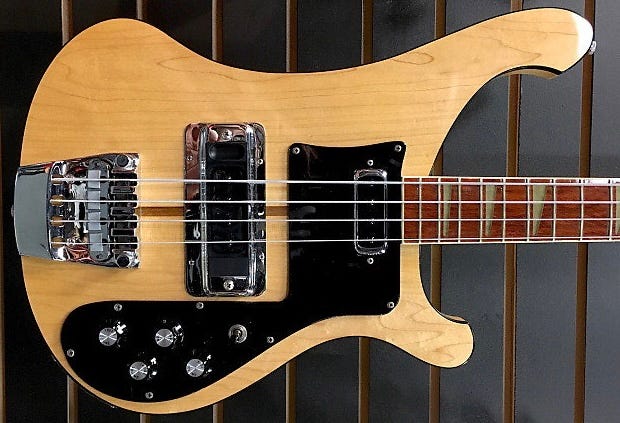
For 1975, Mapleglo got the Black Trim treatment as an option.
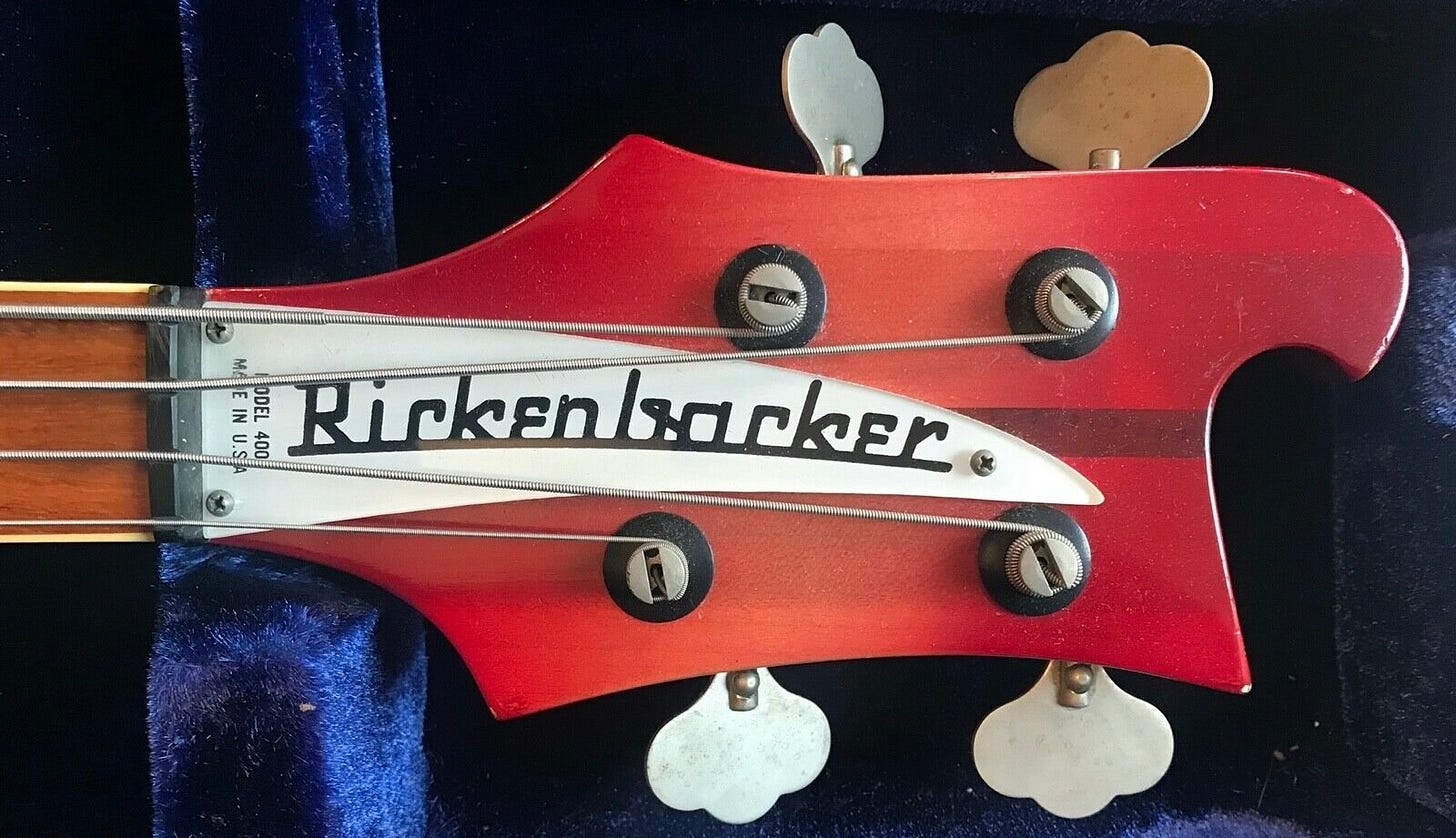
In January a minor change to the Kluson tuners rolled out, with the small nickel bushings being replaced with large black plastic bushings.
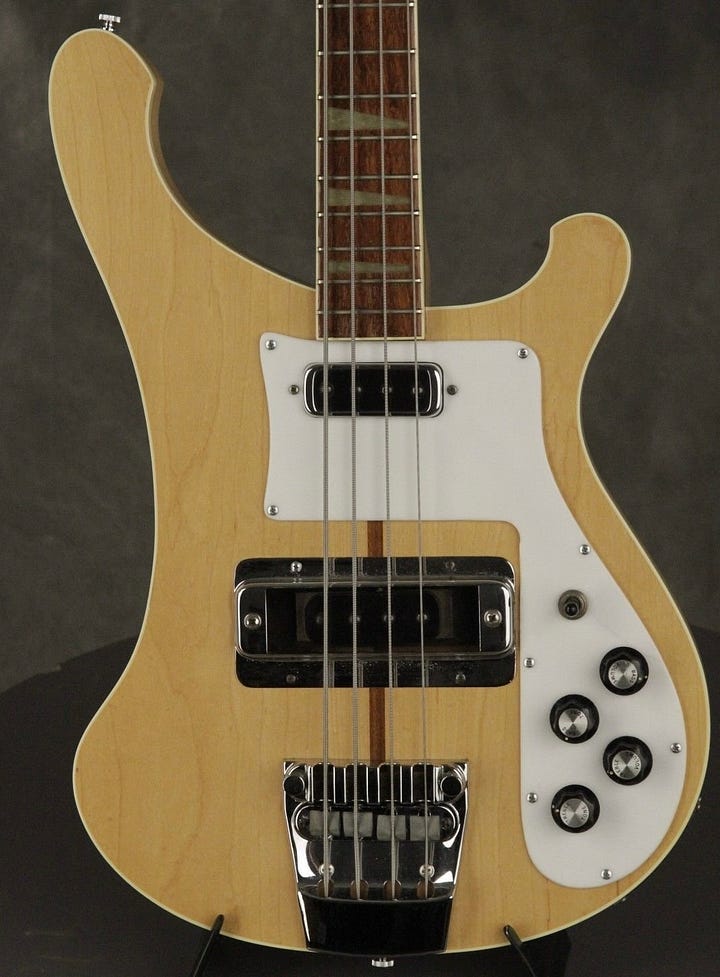
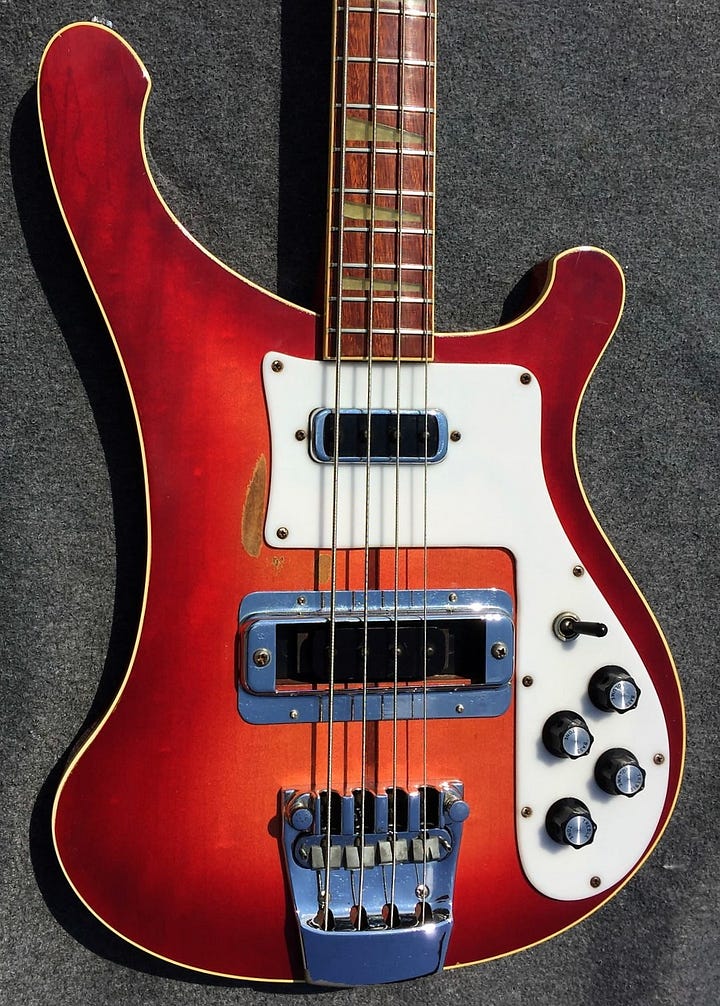
Around May/June, the neck pickup was shifted approximately 1/2” inch towards the bridge. Two theories exist as to why. A) placing the pickup where the natural octave is gives better tone. B) moving the rout further into the body provided more neck strength. My money is on B!

Around September/October the back painted plexiglass truss rod covers began phasing out, replaced by an injection molded cover with a raised and painted logo. “MADE IN U.S.A.” and “MODEL 4001” were stamped at the bottom, above the nut. The raised letter TRCs came in white or black as appropriate
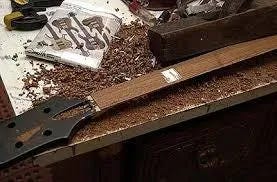
So it’s hard to pin down an exact date for this one, so we’re going to say “around 1975”. “Around 1975” a lead weight was added to the underside of the fretboard between the fourth and fifth frets. The weights had first appeared on the 3001 bass in 1974 to eliminate dead spots on the fretboard, and at some point after that they were added to the 4001 as well. The weights were recessed inside a cavity about 1” square and 1/8” deep.
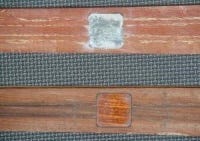
And this last one is really hard to pin down an exact date on. Some sources say as early as 1973, but most say 1975 so we’re gonna go with that. So at some point in 1975 (?), the chrome plated plastic bridge cover changed. The “legs”’went from short:
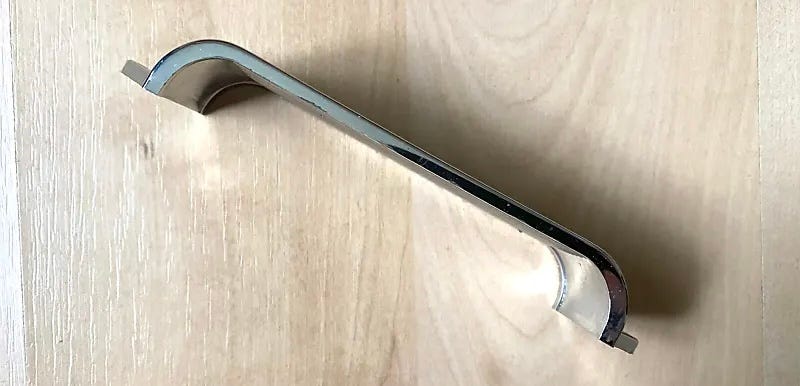
To long:
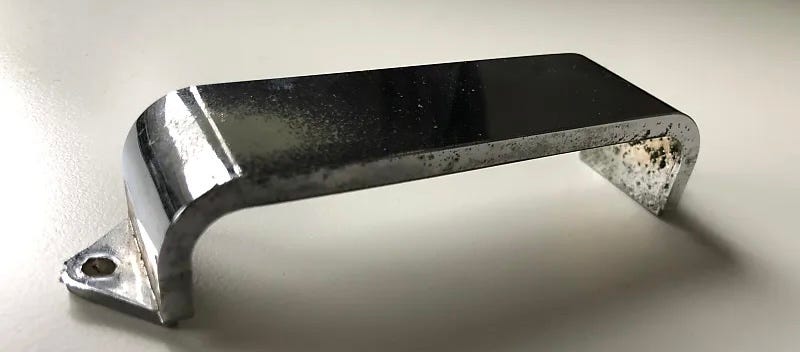
On the shorter version, the springs around the screws that adjust pickup height are placed below the mounting ears, keeping the cover at a constant height regardless of pickup height. On the longer version, the screws are placed on top of the mounting ears, causing the cover to raise and lower along with the pickup.
1976-1980
After years of constant tinkering, Rickenbacker finally declared the 4001 “just right”. There would be no significant changes over a six year period.
That said, while it is hard to quantify or provide specific dates, it is undeniable that the 4001–especially the horns—gradually got “chunkier” between 1972 and 1976-ish, where it seems to have stabilized. Given that there is no clearly identifiable point where “it happened”, it was likely a result of a cycle of aging and worn tooling being used to make new tooling.
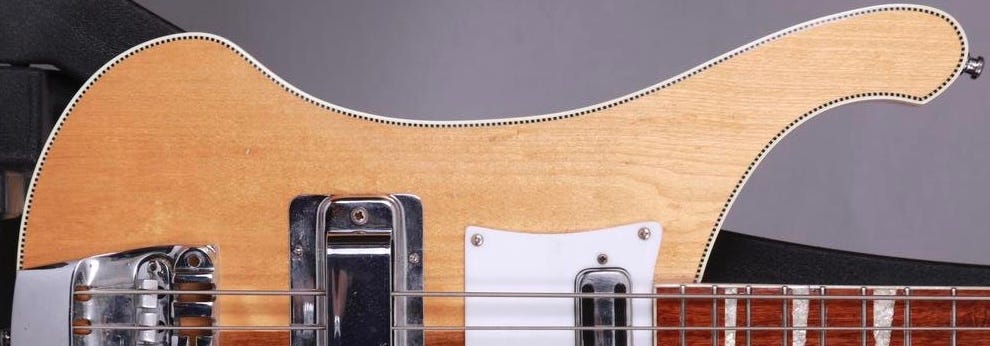
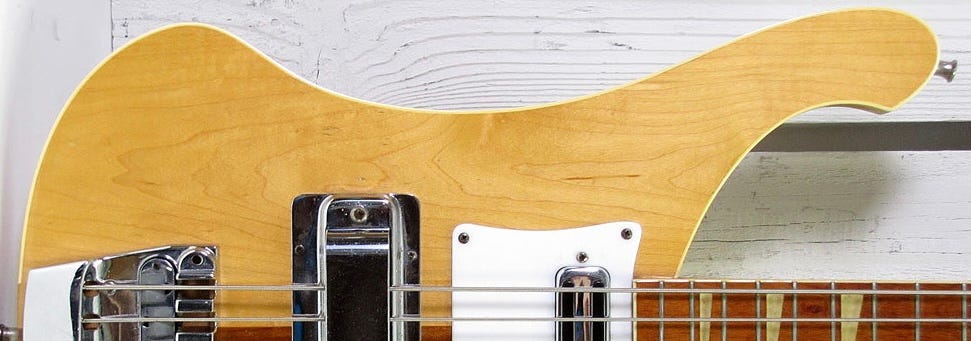
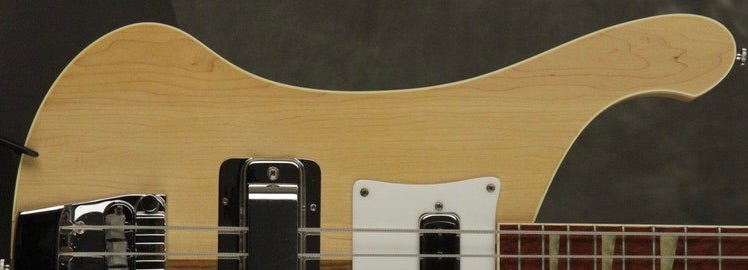
1980
The 4001 was almost twenty years old at this point, and while demand for the 4001 was still strong, the demands on the 4001 had changed. The thin neck that had been designed for the tapewound strings of the early 1960s could not stand up to the increased tension of the heavier roundwound strings players were using—you would void your warranty if you did! Enter the 4003.

While cosmetically and electronically almost identical to the 4001, the neck was beefed up considerably, and the truss rod orientation changed. While the 4001 would be sold side by side with the 4003 for a few more years, its sales numbers declined rapidly and the only changes made would be of necessity.

1982
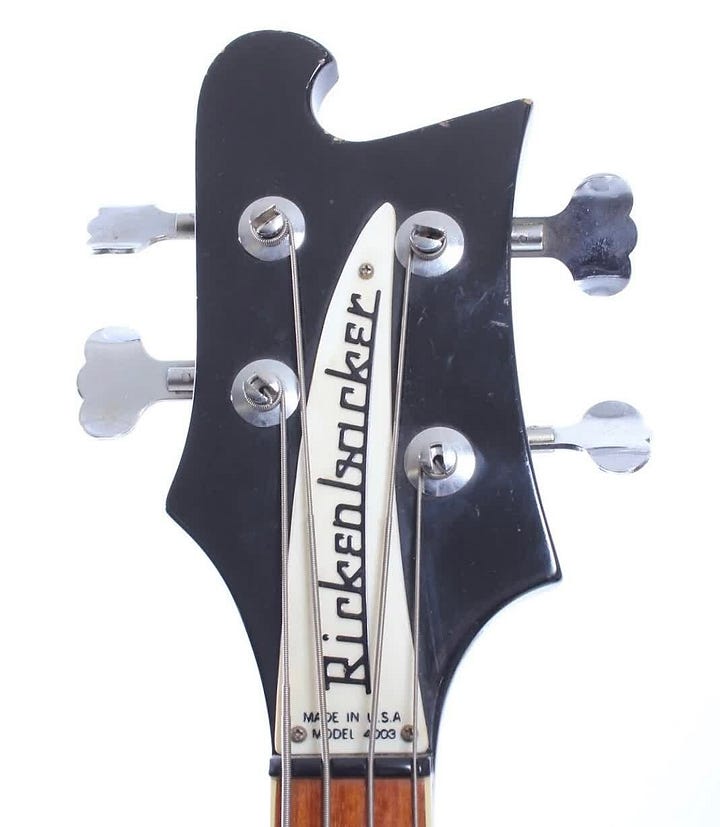
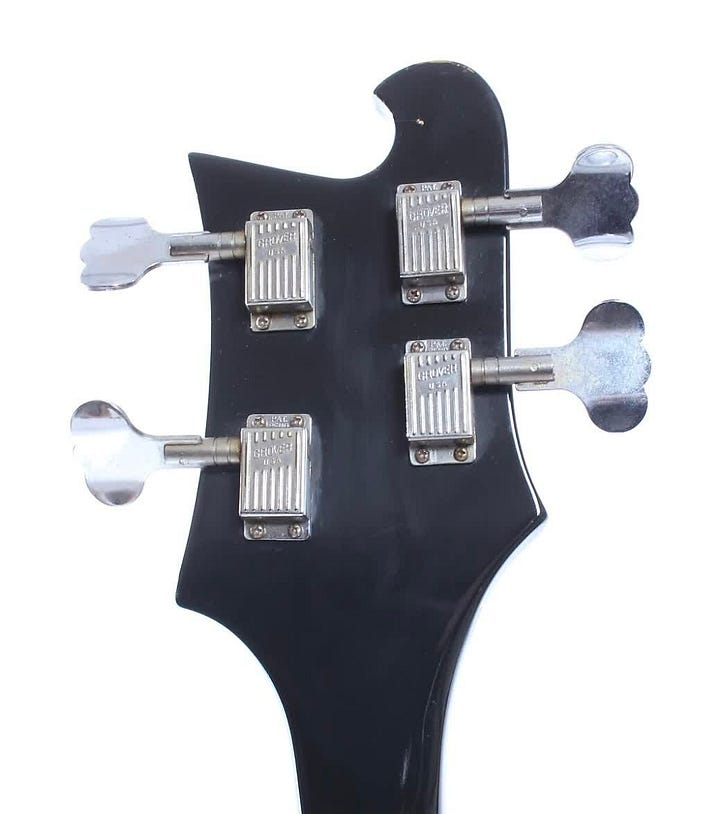
After years of declining sales, Kluson closed their doors in 1982, leaving Rickenbacker without a tuner supplier. They went the easy route and in July began replacing the Klusons with the “wavy” Grover Slimlines that the Klusons had themselves replaced in 1974.
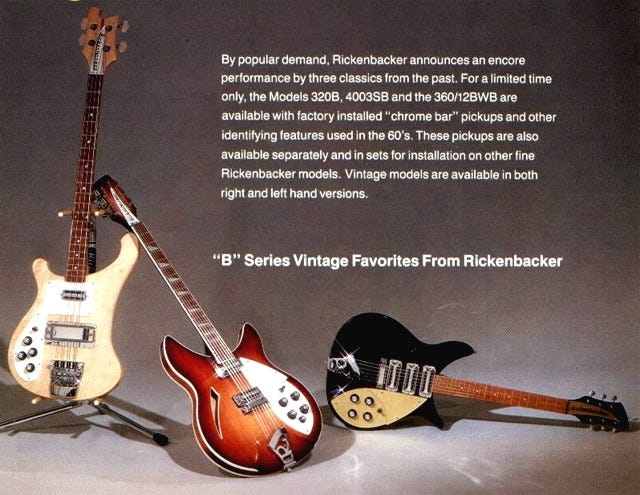
Rickenbacker’s first attempt at vintage/reissue models were launched in 1982 as the “B-Series” guitars. Meant to evoke the three most famous Beatle guitars, the B-Series took current production models and added a few “vintage” cosmetic tweaks. Key among those tweaks was the reintroduction of the toaster pickup—referred to above as the “Chrome Bar pickup” as “toaster” had not yet really entered the lexicon. However, these pickups were wound extremely hot—12k ohms as compared to the original toasters’ 7.4k-ish ohms—so really fall mostly into the cosmetic change category.
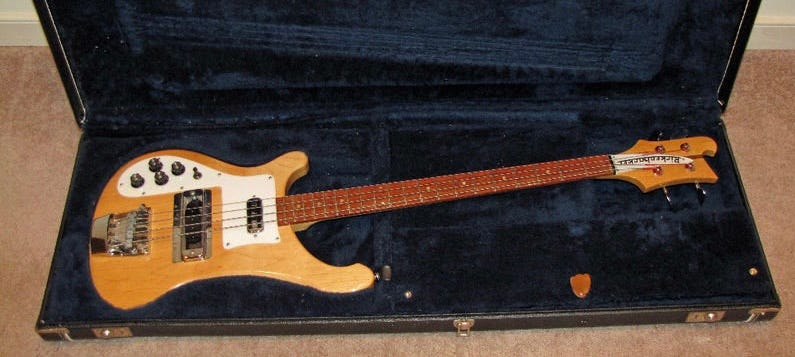
While production B-Series basses used the relatively new 4003S—which featured skunk stripe-less through neck construction—as a foundation, prototypes, like the ones in the pictures above, date as far back as 1979 and used the older, set neck 4001S. Other than the new “Chrome Bar” pickup at the neck, the only other modification was a backpainted plexiglass truss rod cover—the first since 1975. The “MADE IN U.S.A.” stamp, however, was perpendicular to the Rickenbacker logo when it “should” have been parallel.
1985
1985 was the last year the 4001 appeared on the pricelist, but very few were actually produced. It appears that the last “true” 4001s built were built in December.
And that was the end of the 4001, the most important guitar in Rickenbacker history. Well, kinda the end. You see, even after the 4001 was officially discontinued there have been a number of “new” 4001 models…that aren’t actually 4001s. Let me explain.
So we mention the launch of the 4003 above, and how that guitar was designed to handle the higher string tension of modern roundwound strings. Externally it was very similar to the 4001, but internally quite different. As Rickenbacker delved more seriously (than the B-Series!) into vintage/reissue guitars, the modern 4003 was used as the foundation for these guitars, leading to guitars that are technically a 4003 bearing the 4001 name. That process actually began BEFORE the 4001 was discontinued, in…
1984
The 4001V63, the first “proper” attempt at a vintage reissue instrument, was meant to evoke the 1964 4001S gifted to Paul McCartney in 1965 that he used extensively in The Beatles’ later years and during the Wings era. While later attempts would evoke different “eras” in that guitar’s life, this one was meant to look “factory fresh”.
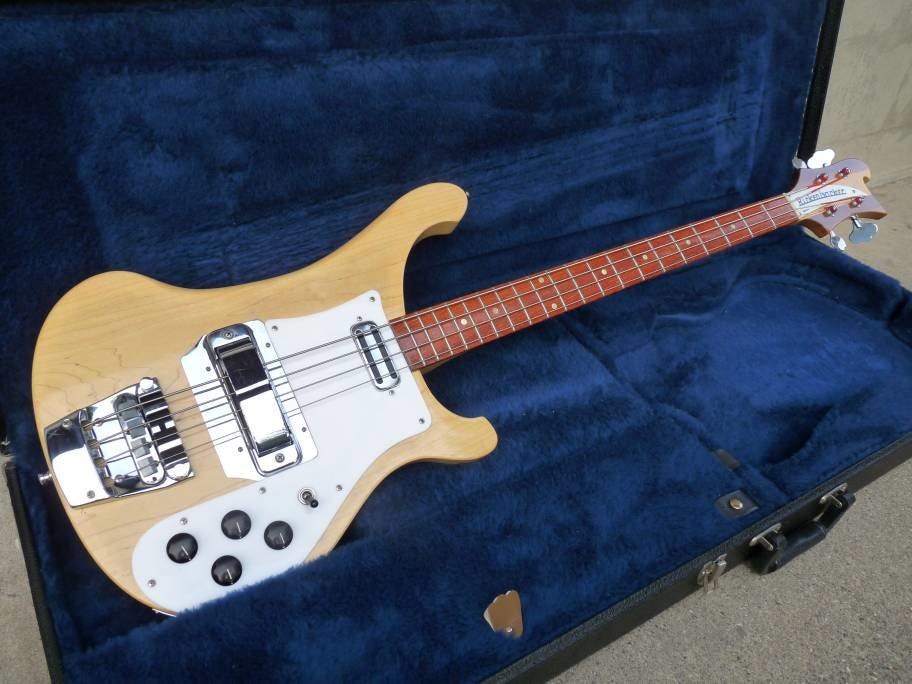
Using the 4003S as a foundation and offered in Fireglo, Jetglo, and Mapleglo at launch, it got a lot right cosmetically: a toaster pickup (albeit the period “hot/12k” version) in the correct ½” neck position. A “long” pickguard. A “long” headstock with walnut wings. An era-correct plexi TRC. A “gap-tooth” bridge—but with the two extra mounting screws that were added in 1973. And a horseshoe pickup at the bridge.
Well, kinda. It’s a fake. It’s really a Higain with fake horseshoe magnets for cosmetic purposes. Although there are rumors that some of the very first examples got true, “leftover” horseshoe pickups. And maybe that’s true?
So that’s a lot right. What’s wrong? Well, some things are easy to point out. The Schaller tuners have larger bushings than the original Klusons did. The wiring does not include the “vintage tone circuit”. And the bridge had the aforementioned extra two mounting screws.
Minor spec changers occurred over the life of the guitar (which I’m not going to break down year by year). Some were for the good—the hot toaster switched over to a scatterwound when those appeared around 1999, and some for the bad—like the neck, which got chunkier over its lifespan. And then let’s talk about the headstock.
In 1964 there was no left handed headstock, so McCartney’s had a “backwards” right handed headstock. But when THIS guitar was made, there WAS a left handed headstock, so that’s what the guitar came with stock—making left handed versions “wrong”.
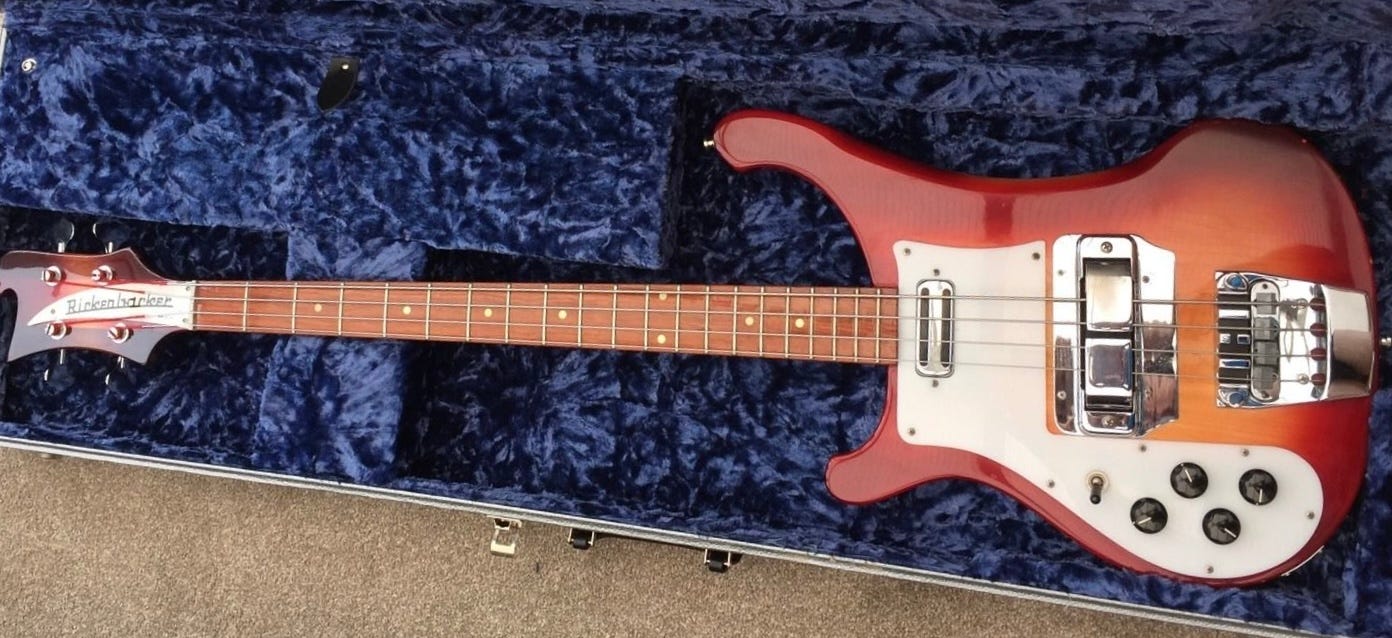
Except…there was a “PMC option” on the lefty to flip the headstock “upside down” to match the original, and a fair number of people did—there was even a special run of PMC guitars for Japan in 1999.
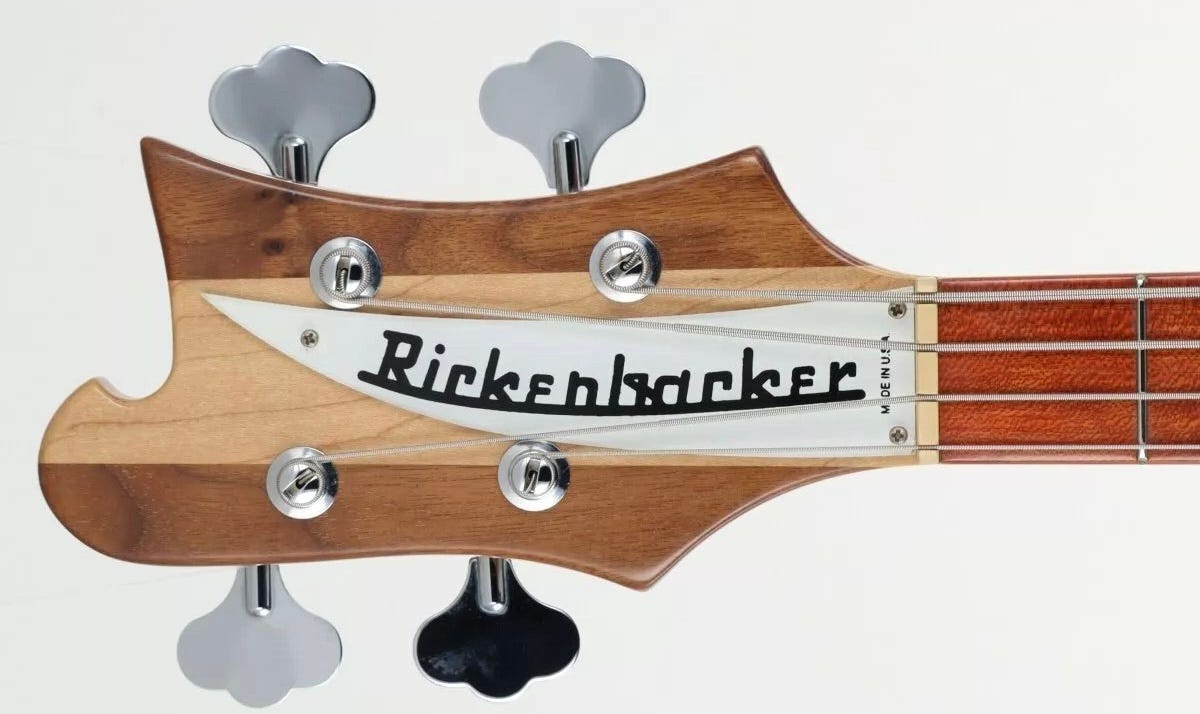
So overall, not bad…but it could be better. The 4001V63 would run through 2002.
1991
The Signature Limited Edition line began in 1987 with the 1997PT Pete Townshend model, and in 1991 we saw the first bass entry: the 4001CS Chris Squire model.

Is it more or less the same guitar as the 4001V63? In many ways yes, but there are some key differences.
Again the guitar was designed to evoke the 1964 4001S/1999–as modified by Squire—and based off a 4003S foundation. Most of the differences from the 4001V63 were cosmetic. But not all!
The guitar is particularly prized today for the very slim profile of its neck—much slimmer than the period 4003S or even the 4001V63.
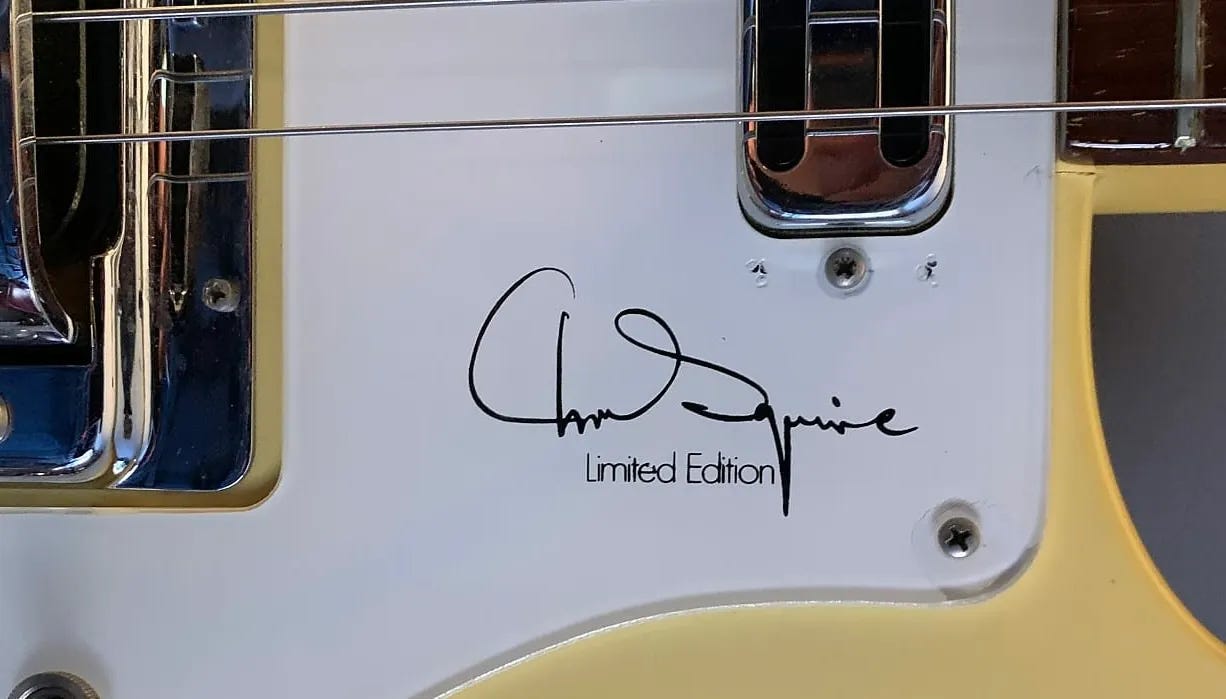
Most appointments are the same as on the 4001V63, apart from the backpainted plexi pickguard that includes Squire’s signature. The most obvious difference—apart from the cream finish—is the dark vermillion fingerboard and headstock wings. Or are they?
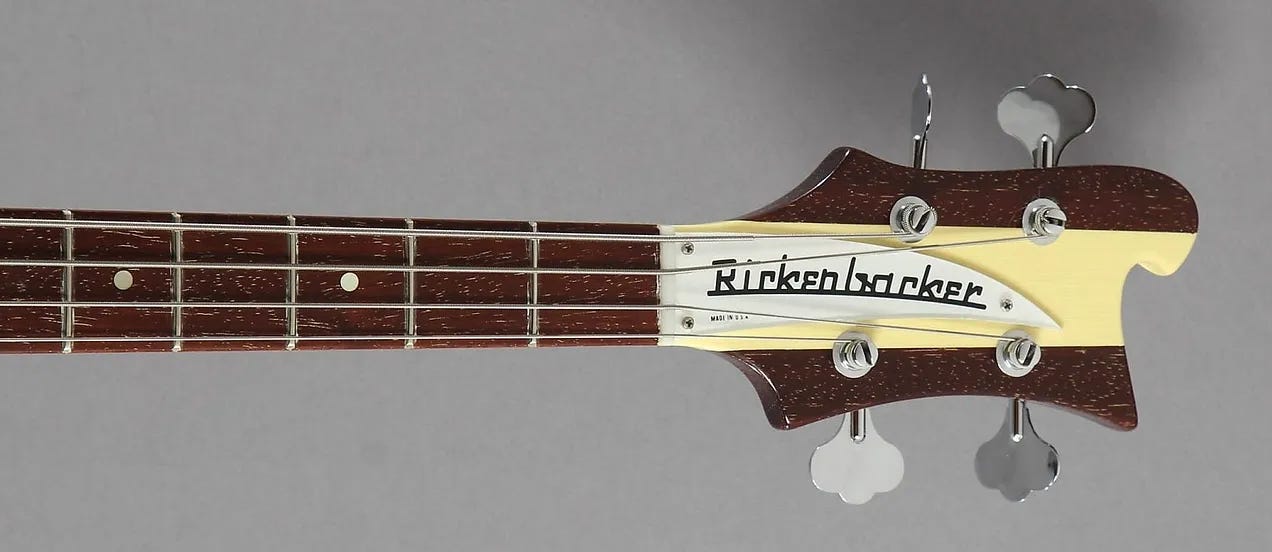
Despite what the press release may have said, John Hall is on the record as saying “nope”. Vermillion is a term most commonly associated with woods like padauk or pao ferro, and Hall says neither was used here. No matter what it actually is, it’s much darker than the woods normally used here and really makes the model stand out.
1000 4001CS models were produced between early 1991 and 2000. With such a long production period some slight changes occurred over time, most notably with earlier guitars tending to have thinner necks than later examples.
2002
2002 saw the launch of two “improved” versions of the 4001V63: the 4001C64 and 4001C64S. So what’s the difference between the two? And what are the differences from the 4001V63?
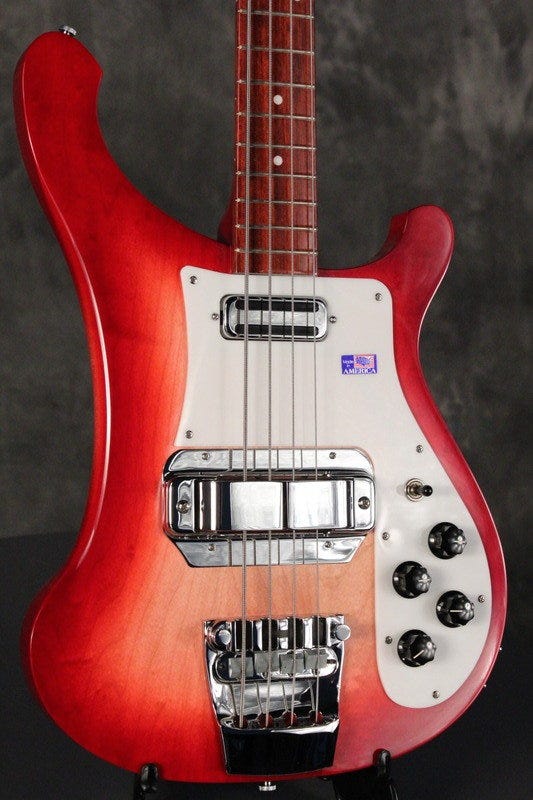
The 4001C64 was meant to be a “factory fresh” 1964 4001S reproduction. Again based on the period 4003S, it addressed some of the details the 4001V63 got wrong. Like the vintage tone circuit. Like the bushings on the tuners. Like removing the two extra mounting screws from the bridge. But then there’s the headstock.
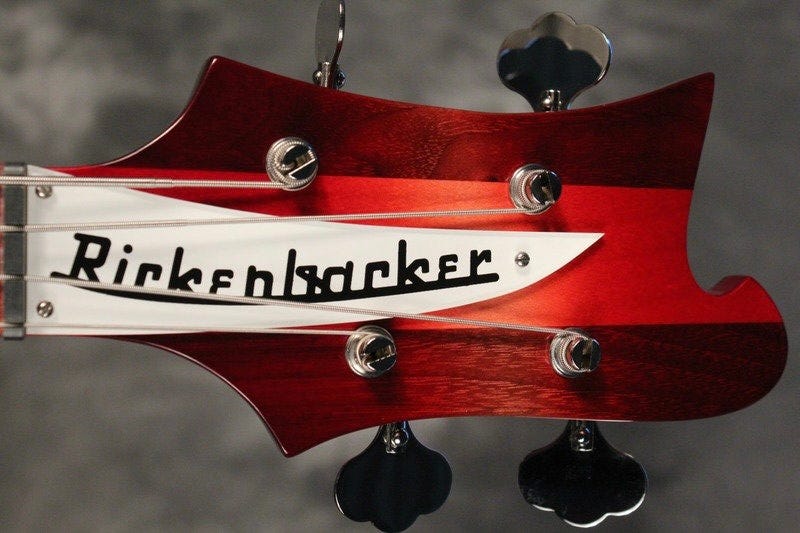
They overcompensated a bit by giving ALL guitars a backwards headstock like McCartney’s. Which means lefties got a “correct” right handed headstock, but right handed guitars also got a backwards left handed headstock. It’s a little weird, frankly.
The 4001C64S was meant to evoke McCartney’s Wings-era modifications to his 1964 4001S, so it obviously has some differences from the 4001C64.

In removing the finish, McCartney had aggressively sanded the guitar, removing the crests from the horns, duplicated here. Both the bridge pickup and bridge had been replaced on his guitar, and the 4001C64S wears appropriate replicas.
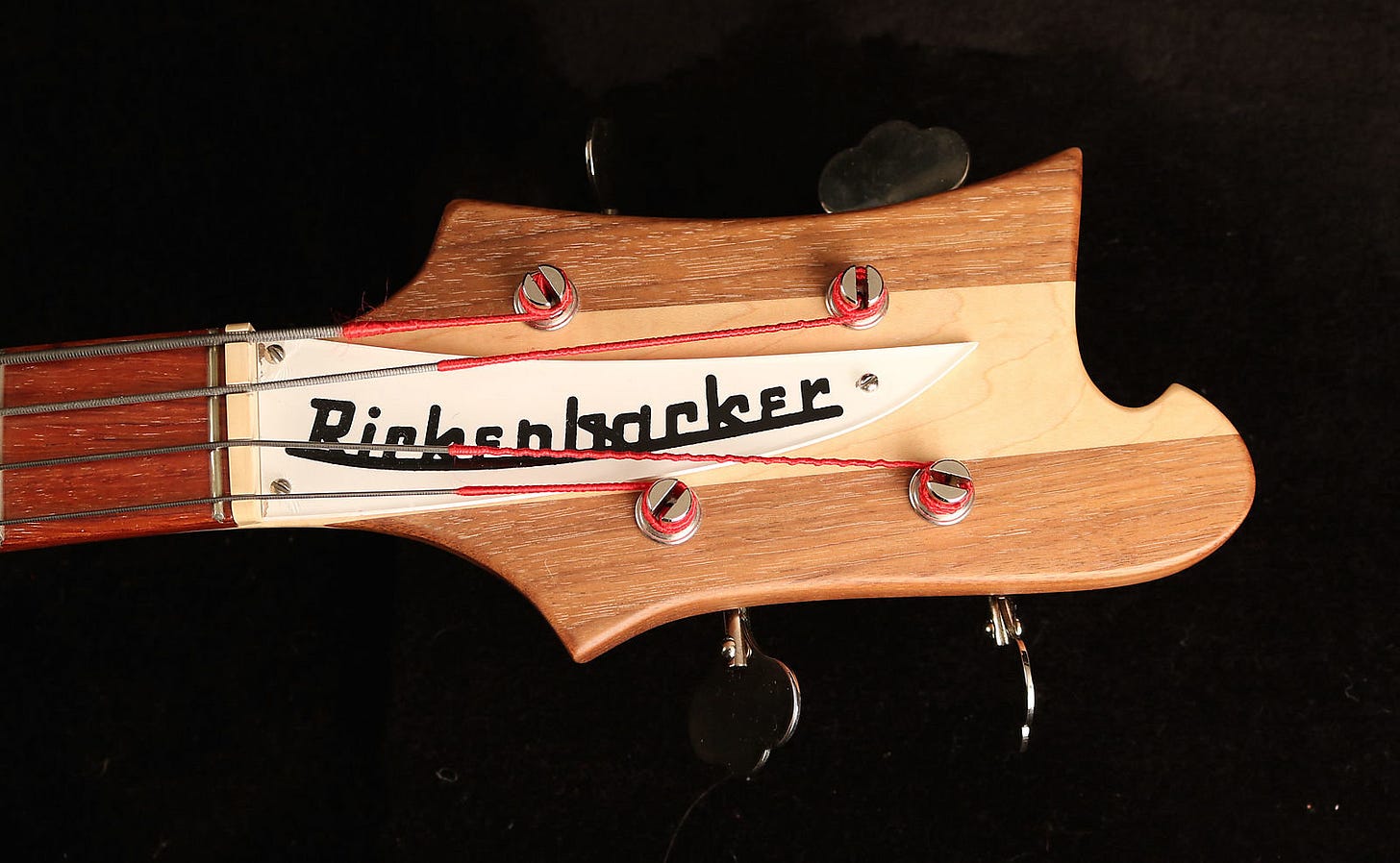
And at the top, the black nut had been replaced by a white one, and a zero fret had been added.
The 4001C64 and 4001C64S were produced through 2011.
2014-Present
A handful of McCartney-esque 4001S special runs have been produced using a 4003S foundation, like this 2014 example:
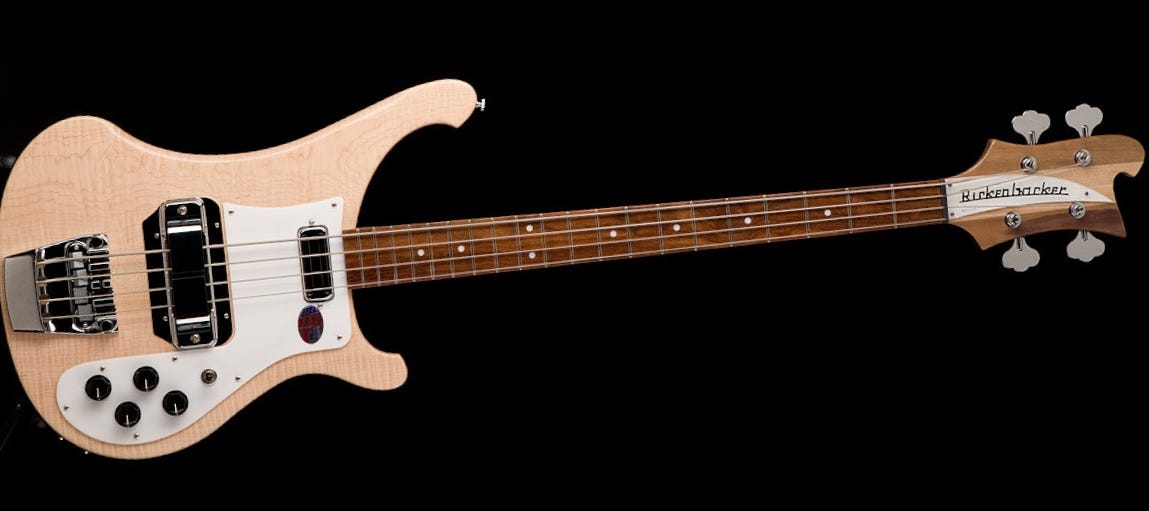
While the 1996 transition to CNC manufacturing had substantially pared down the 4003’s cutaway horns, the previous McCartney-inspired guitars had used their own body templates more in line with the 1964 originals. It’s thus a little incongruous to see these skinny horns on a “McCartney”-esque guitar!
And that is, as of today, the complete tale of the 4001! As careful as I have tried to be, I have almost certainly gotten things wrong. If you see something, call it out in the comments and I’ll fix it!
Want to learn more about…everything? Check out the rickenbacker101 site map here and see what’s available!




Wow Andy - what an incredible amount of information! My guess is that your full but yet completed bibliography should reside in the reference section of International Guitar Library (I made that up). I am not a bass player and never owned one but anyone with an interest in Ric guitars, bass guitars, and particularly with the 4001 should read your column. Labor of love. Stellar research.
Thank you so much for this in depth overview of the 4001. This will surely be a “go to” for buyers of both new and s/h 4001 and 4003 basses. As for corrections I’m sure there will be a few headed your way (as you rightly say)..but hey, this is Rickenbacker! On the subject of the 4001CS I have the “RIC poster” CS which was made in August 1990 used for promoting the new signature series and as there was no prototype I believe its number 1. I bought the bass directly from the (then) UK Rickenbacker office when the bass was on its way back from Frankfurt Music Messe in Jan 1991. Once again thank you so much for putting this timeline together!